Managing and Reporting on the Performance and Cost of Capital Projects
Overview
This report was initially tabled on 4 May but has been reissued because information in the original report was incorrect and needed to be updated as a matter of public record. More specifically, the original report mistakenly identified a Royal Children’s Hospital ICT investment project as being over approved time and over budget. See the transmittal letter on page iii of the report for more detail. It should be noted that the removal of the Royal Children’s Hospital ICT investment project had only a minor impact on the aggregated numbers and did not materially affect the report’s findings.
The limited transparency on the status of government's major capital projects means Parliament and the public cannot easily access information on the progress of each project against cost and time line targets.
While it is encouraging that agencies are using the Department of Treasury & Finance's (DTF) Investment Lifecycle and High Value/High Risk Guidelines (lifecycle guidelines), our more detailed examination of 15 projects showed gaps or weaknesses in around half the documentation reviewed. This is a significant concern because complying with the guidelines can help mitigate the risks that projects will be late, over budget or not adequately define and deliver on their intended benefits.
The report's recommendations highlight the need for:
- DTF and the Department of Premier & Cabinet to advise government how best to track the progress of government capital projects and make this information available to Parliament and the community
- DTF to periodically review agencies’ performance in applying the lifecycle guidelines
- individual agencies to appropriately assess and improve compliance with the lifecycle guidelines.
Transmittal letter
Ordered to be published
VICTORIAN GOVERNMENT PRINTER June 2016
PP No 154, Session 2014-16
President
Legislative Council
Parliament House
Melbourne
Speaker
Legislative Assembly
Parliament House
Melbourne
Dear Presiding Officers
Under the provisions of section 16AB of the Audit Act 1994, I transmit my revised Managing and Reporting on the Performance and Cost of Capital Projects report, to be tabled in lieu of the original report tabled on 4 May 2016.
Your Clerks advised that this revised report should be tabled after I became aware that information in the original report was incorrect and needed to be updated as a matter of public record. More specifically, the original report mistakenly identified a Royal Children’s Hospital ICT investment project as being over approved time and over budget.
The removal of reference to the Royal Children’s Hospital ICT investment project being over approved time and over budget in this revised report has resulted in this project being deleted from Figure 2O on page 29 and Figure 2R on page 32 as well as showing that the project is on time and budget in Figure C1 on page 54. The removal also had flow-on impacts to the aggregated numbers referred to in the Audit summary paragraph five on page xi, Figure 2A on pages 15 and 16, Figure 2D on page 18, Figure 2N (and the associated text) on page 29, the text on pages 29 and 30 associated with Figure 2O, as well as Figures 2P and 2Q (and the text associated with them) on page 31.
It should be noted that the removal of the Royal Children’s Hospital ICT investment project had only a minor impact on the aggregated numbers and did not materially affect the report’s findings.
Yours faithfully

Dr Peter Frost
Acting Auditor-General
8 June 2016
Auditor-General's comments
|
Dr Peter Frost Acting Auditor-General |
Audit team Ray Winn and Michael Herbert—Engagement Leaders Rocco Rottura—Team Leader Hayley Svenson—Team member Engagement Quality Control Reviewer Tony Brown |
The state is investing billions of dollars in its capital works program to improve and build hospitals, schools, roads, public transport and other infrastructure to support the delivery of a wide range of important services.
Parliament and the community rightly expect that publicly funded capital investments are planned and managed in a way that delivers the predicted benefits on time and within allocated budgets. The scale and complexity of capital projects in the State Budget mean that successful delivery represents a major challenge for public sector agencies. Unexpected cost blowouts can significantly impact the state's finances and affect the government's ability to deliver its wider policy agenda. Unforeseen delays also mean the community has to wait longer for the promised benefits, and unreliable benefit estimates risk distorting government's decision-making.
Previous VAGO reports on major infrastructure have identified significant weaknesses and recommended improvements in the way projects are developed and delivered, and in how outcomes are measured and reported.
This audit builds on those previous audits of individual major projects. It is a broader examination of projects with a total estimated investment of $10 million or more, and which are listed in the 2015–16 State Capital Program Budget Paper. Specifically, I examined how effectively agencies manage the time, cost, scope, development and delivery of major capital projects.
Despite the significant capital expenditure, I found that obtaining current information on capital projects across the public sector is a complex and challenging exercise and there is limited public reporting. This lack of transparency makes it difficult to determine whether investments have enhanced government services and whether public resources have been spent in an efficient, effective and economical way. Some agencies found providing the information requested for this audit onerous and resource intensive. This raises concern about the level of scrutiny they apply to their capital projects as part of their governance processes.
The information provided shows that a high proportion of agencies purport to prepare capital project documentation in line with the Department of Treasury & Finance's (DTF) Investment Lifecycle and High Value/High Risk Guidelines (lifecycle guidelines). However, my more detailed examination of 15 projects showed gaps or weaknesses in around half of the documentation reviewed. This is a significant concern because complying with the lifecycle guidelines can help mitigate the risks that projects will be late or over budget or will not adequately define and deliver their intended benefits.
My recommendations accordingly target the need for agencies to implement a documented and consistent approach to verify that they have complied with DTF's lifecycle guidelines. They also address the need for DTF and the Department of Premier & Cabinet to advise government on how best to track the progress of capital projects and make this information available to Parliament and the community. By providing this information, the government can improve project transparency and accountability, and allow the public to compare projects using standardised metrics across agencies. Further, it will make it harder for underperforming projects to go unnoticed and easier for government to focus effort on projects where it is most needed.
In future years, I intend to use the information obtained in this audit to identify selected capital projects for more focused audits.
Finally, I wish to thank staff at the agencies for their assistance and cooperation during this audit.

Dr Peter Frost Acting Auditor-General
May 2016
Audit Summary
Background
The effective planning and delivery of major capital projects is critical to governments achieving their policy objectives. If delivered well, infrastructure enhances services to the public and improves productivity. Poor management diminishes the benefits of these projects, potentially delays delivery and creates additional costs for taxpayers.
In 2015–16, the total estimated investment in new and previously announced projects in the State Capital Program Budget is approximately $52 billion, comprising $28 billion in existing and $24 billion in new investments.
Previous VAGO reports on major infrastructure investments have identified significant weaknesses and recommended improvements to the way projects are developed and delivered, and in how outcomes are measured and reported.
The Department of Treasury & Finance (DTF) and the Department of Premier & Cabinet (DPC) advise government on infrastructure investment and delivery.
DTF also has oversight of the Investment Lifecycle and High Value/High Risk Guidelines (lifecycle guidelines) that guide project development and delivery.
DPC in consultation with DTF is responsible for setting up Projects Victoria, a new entity, that is expected to oversee the delivery of all major capital projects, research and develop appropriate delivery models, review and improve capability in project development and delivery, and publicly report on their performance.
Although guidance and support is currently provided centrally, the government's devolved model of responsibility means that individual agencies are responsible for developing and successfully delivering infrastructure projects.
Objectives and scope of this audit
The objective of the audit is to assess how effectively agencies manage the time, cost, scope, development and delivery of major capital projects by examining whether they have:
- developed business cases that provide a sound basis for the government to decide if, and in what form, investments should proceed
- developed sound procurement processes
- monitored and managed projects' progress and risks during delivery
- demonstrated that completed projects have achieved the intended outputs and outcomes.
The audit examined self-attested information from agencies and included a limited examination of key project documentation for a sample of 15 projects, to verify its completeness and help focus future audits of major infrastructure projects. Specifically, the audit assessed whether the documents included content as required by the lifecycle guidelines and how well this material addressed the requirements.
The audit scope includes Victorian public sector agencies responsible for managing capital projects with a total estimated investment of $10 million or more, as listed in the 2015–16 State Capital Program Budget Paper.
Conclusions
The limited transparency on the status of government's major capital projects means Parliament and the public cannot easily access information on the progress of each project against cost and time targets.
The difficulty many agencies had in providing basic information also raises concerns about the current level of scrutiny they apply to these projects as part of their governance processes. Had agencies been properly monitoring their investments, the information sought for this audit would have been readily available.
While it is encouraging that agencies are using DTF's lifecycle guidelines, our more detailed examination of 15 projects showed gaps or weaknesses in around half of the documentation reviewed. This is a significant concern because complying with the guidelines can help mitigate the risks that projects will be late or over budget or will not adequately deliver their intended benefits.
The governance and ongoing monitoring of a small number of projects were affected by the absence of key project documentation because it had been subject to the Cabinet-in-Confidence processes of a previous government. In these cases, agencies mistakenly assumed they no longer had access to critical documents, such as business cases. However, mechanisms do exist which enable agencies to retain or obtain assess to Cabinet-in-Confidence material where it can be justified that it relates to ongoing business. However, this is not comprehensively understood across all public sector agencies.
Findings
Self-attested survey and provision of documents
The 30 audited agencies identified a total of 251 projects within the 2015–16 Budget Papers as being above the $10 million threshold for this audit. These projects have a combined total estimated investment of $35.7 billion.
The self-reported and attested information obtained through the survey indicates that a high proportion of agencies are preparing documentation in line with DTF's lifecycle guidelines,including establishing appropriate governance and management structures.
Of the 251 projects, 47 projects were at the initiation stage and two were postponed while in the initiation stage, meaning they would not yet have business cases. Of the remaining 202 projects, well over 90 per cent had the relevant information within business cases or supporting plans. However, only 65 of the 197 projects with a business case (33 per cent) reported reviewing the business case after approval. Further, benefits management plans were reported as being reviewed for only 24 of the 35 projects where there were changes in the project scope, costs or time lines after the business case was approved.
Similarly agencies reported that of the 155 projects that had undertaken procurement, over 85 per cent had prepared a procurement plan and tender evaluation report. However, despite a requirement that probity plans are prepared for all projects over $10 million, 38 projects (25 per cent) had not done so. Without a probity plan, it is unclear how agencies manage probity risks including tender communications, late tenders, tender security, confidentiality and intellectual property.
Agencies indicated that only 12 of 41 completed and terminated projects (29 per cent) had undertaken post-implementation reviews. For the vast majority of the remaining projects, agencies advised they planned to do so.
Despite agencies asserting that a high proportion of projects have capital project documentation in line with the lifecycle guidelines, a significant number of projects are, or are expected to be, over budget and/or late. Of these:
- eight of 215 projects (4 per cent) are over budget by more than 5 per cent or $47.6 million in total
- 70 of 212 projects (33 per cent) are either completed or forecast to be late.
Limited examination of 15 projects
Agencies are clearly using the lifecycle guideline templates to structure their project documentation. While this is encouraging, in about half of the documentation reviewed there were significant gaps or weaknesses in the content used to populate these templates.
Some agencies fell short of the standards required in describing the benefits, documenting the solution, analysing the options, proving deliverability and identifying the probity risks. This raises concerns about the reliability of the self‑reported and attested information submitted in response to our survey.
The absence of documentation for three of the 15 selected projects is a significant issue, as it is impeding effective project governance by agencies and means we have been unable to assess if these projects addressed key elements in the investment lifecycle guidance. For one of these projects, a business case for the full program of works is under development and expected to be submitted to government in mid-2016. For the other two projects, the agency could not provide critical documentation (e.g. full business cases), because these had been put in secure storage and not returned under the current Cabinet conventions covering a change of government. Our follow-up inquiries to DPC have been unsuccessful in locating and accessing these documents.
Recommendations
- That the Department of Treasury & Finance and the Department of Premier & Cabinet advise government on how best to establish a public reporting mechanism that provides relevant project status information on capital projects costing $10 million or more, planned and actual costs, time lines, governance arrangements, and the extent to which benefits are realised.
- That agencies implement a documented and consistent approach to verify that they have adequately addressed the requirements of the Department of Treasury & Finance's Investment Lifecycle and High Value/High Risk Guidelines for government-funded capital projects.
- That the Department of Treasury & Finance periodically reviews agencies' performance in applying the Investment Lifecycle and High Value/High Risk Guidelines for projects costing $10 million or more and provides feedback to agencies on areas requiring improvement.
Submissions and comments received
We have professionally engaged with the surveyed agencies listed in Appendix A and the Department of Premier & Cabinet, the Metropolitan Fire and Emergency Services Board, VicTrack and RMIT University throughout the course of the audit. In accordance with section 16(3) of the Audit Act 1994 we provided a copy of this report, or part of this report, to those agencies and requested their submissions or comments.
We have considered those views in reaching our audit conclusions and have represented them to the extent relevant and warranted. Their full section 16(3) submissions and comments are included in Appendix D.
1 Background
1.1 Introduction
The quality of life and economic success of any community is heavily influenced by the quality of its water supply, sewerage systems, roads, public transport, education facilities, health facilities, communications systems, communal facilities and recreational infrastructure.
The effective planning and delivery of major capital projects is critical to governments achieving their policy objectives. If delivered well, infrastructure enhances services to the public and improves productivity. Poor management diminishes the benefits of these projects, potentially delays delivery and creates additional costs for taxpayers.
1.2 State Capital Program
The state is investing billions of dollars in its capital works program to build and improve hospitals, schools, roads, public transport and other infrastructure. For 2015−16, the total estimated investment (TEI) in new projects and previously announced projects still under construction in the State Capital Program Budget is approximately $52 billion. This includes $28 billion in existing investments and $24 billion in new investments.
Figure 1A shows that the transport sector—comprising roads, rail and ports—accounts for the largest proportion of expenditure, with a TEI of $30 billion, making up 58 per cent of the State Capital Program.
The utilities sector—which includes water infrastructure—is second in terms of expenditure, with $14.3 billion in projects. The balance of the state's capital program is invested as follows:
- $3.4 billion in health and human services, including hospitals, medical research centres, health facilities, residential housing for people with disabilities and public and community housing
- $1.5 billion in justice, including courts, police stations, correctional facilities, fire stations and other emergency management stations and facilities
- $0.7 billion in education, including preschool, primary and secondary schools, university and technical and further education (TAFE) institutes
- $0.6 billion in tourism, sport and recreation, including recreational areas, mixed‑use facilities, convention facilities, cultural institutions (such as museums), entertainment facilities (such as music venues and theatres) and sporting facilities, art precincts and galleries, and tourist attractions
- $1.0 billion in other miscellaneous projects.
Figure 1A
Existing and new estimated investment by sector
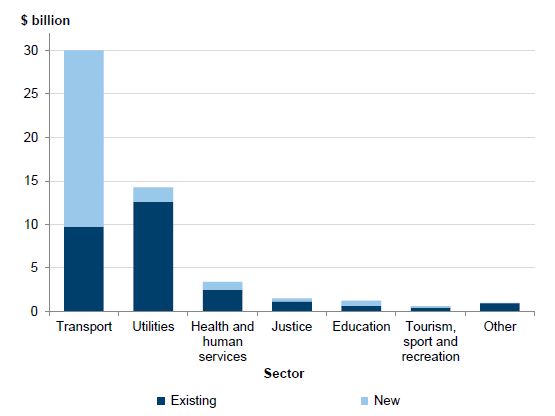
Source: VAGO based on the State Capital Program, Budget Paper No. 4, 2015–16.
Details including the TEI of new and previously announced major infrastructure investments, by sector, are outlined in Figure 1B. The largest Budget commitments include $9–$11 billion to deliver the Melbourne Metro Rail Project and $5–$6 billion allocated for the removal of 50 level crossings. These two projects comprise almost one-third of the State Capital Program Budget.
Figure 1B
Major infrastructure investments, by sector
|
Transport |
|---|
|
|
Utilities |
|
|
Education |
|
|
Health and human services |
|
|
Justice |
|
|
Tourism, sport and recreation |
|
Source: VAGO from the State Capital Program, Budget Paper No. 4, 2015–16, and the Victorian Budget 15/16 for Families.
1.3 Victoria's approach to managing investments
This capital expenditure represents a major investment and financial risk for the state and requires effective planning and management to deliver projects on time and within budget while realising the intended benefits.
Previous VAGO reports on major infrastructure investments have identified significant weaknesses and recommended improvements to the way projects are developed and delivered, and in how outcomes are measured and reported.
The less-than-satisfactory performance of certain projects was also highlighted in the former government's April 2011 Victorian Economic and Financial Statement which referred to 'a range of capital projects beset by inadequate management and very significant cost overrun'. The aggregate impact of these cost overruns was estimated to be in around $2 billion.
1.3.1 Guidance and assurance
In response, the government introduced the High Value High Risk (HVHR) process to provide greater assurance that major projects will deliver the intended benefits within scheduled time lines and approved budgets. Managed through the Department of Treasury & Finance (DTF), the process requires greater centralised oversight of projects that meet one or all of the following criteria:
- a TEI of $100 million or more
- identified as high risk and/or highly complex during planning processes
- considered by government to warrant greater oversight and assurance.
The HVHR process requires the Treasurer's approval of project documentation at key stages in a project's lifecycle.
The HVHR process builds on DTF's existing Investment Lifecycle and High Value/High Risk Guidelines (lifecycle guidelines) and gateway reviews, which involve reviews at the main stages of a project.
The lifecycle guidelines apply to all government departments, corporations, authorities and other bodies falling under the Financial Management Act 1994.
The lifecycle guidelines support the development of business cases which are mandatory for capital investments with a TEI of $10 million or more and provide guidance to agencies across five identified stages of the investment lifecycle, by helping them to:
- conceptualise an investment by establishing the need and defining the benefits
- prove a solution by assessing the costs, benefits and risks of likely options
- procure the investment by awarding a contract that best delivers the solution and provides value for money
- implement the solution to realise benefits and manage costs and risks
- realise the benefits and measure the success of the investment.
Figure 1C shows the investment lifecycle framework.
Figure 1C
Investment lifecycle framework
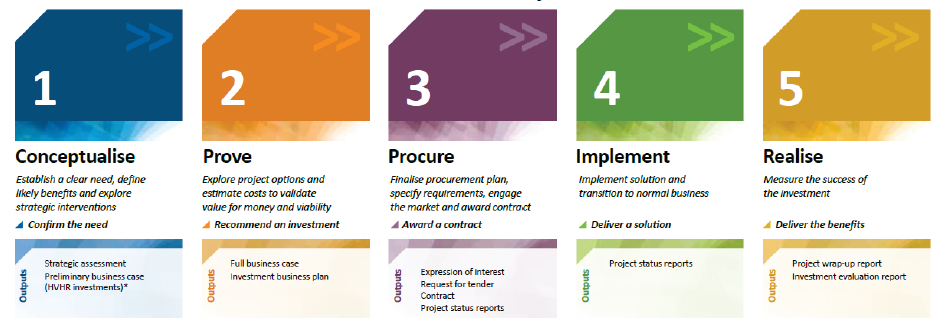
Source: Department of Treasury & Finance, Investment Lifecycle and High Value High Risk Guidelines—Overview.
1.3.2 Capital projects reporting in the Victorian Government
DTF, in consultation with the Department of Premier & Cabinet (DPC), provides information to government on the progress of capital projects on a quarterly basis that:
- examines the progress and performance of departments, public hospitals and TAFE institutes in managing the risks associated with implementing projects
- includes commentary focused on major projects and the most material issues given the magnitude of the state's capital program
- summarises the mitigation strategies implemented and decisions already taken to address identified key risks and issues
- highlights risks and issues with major projects and, where appropriate, proposes recommendations for government consideration.
However, for the public, knowing the status, progress and outcomes of capital projects is currently difficult as there is limited information made publicly available. The public must search various information sources and even then is only likely to gain a limited understanding of progress against cost and time targets.
The use of digital dashboards in other jurisdictions
A digital dashboard is a reporting tool that presents key metrics in an easy to interpret visual interface. It provides a bird's-eye view of key up-to-date information on projects and initiatives.
The transparency provided by a digital dashboard can reveal emerging trends in project expenditure and make it harder for underperforming projects to go unnoticed, and easier for the government to focus efforts where they are most needed.
Governments in other jurisdictions have acknowledged the need to provide greater visibility of their capital projects and activities. For example, the Capital Projects Dashboard used by New York City's Office of the Mayor, shown in Figure 1D, provides a view into the city's most costly infrastructure and information technology projects. The dashboard displays an overview of all capital projects managed by the city with budgets of $25 million or more, and includes a summary status of projects by schedule—the difference between the current anticipated completion date and the previously estimated completion date—and by cost variance.
Figure 1D
New York City's Office of the Mayor, Capital Projects Dashboard
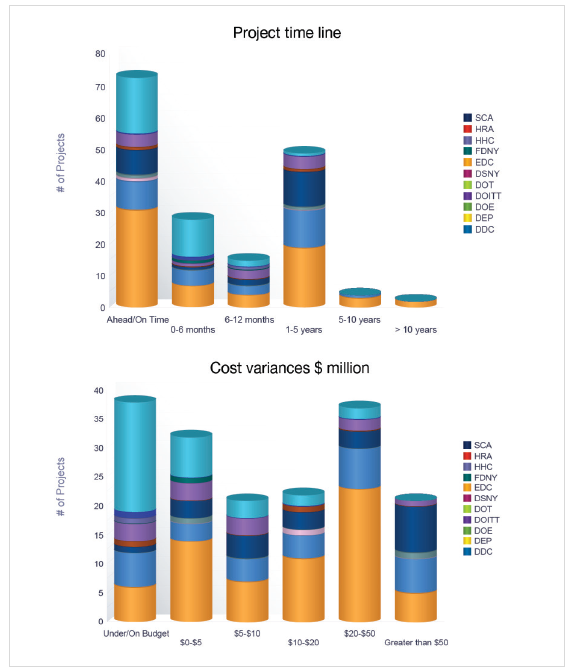
Source: http://www.nyc.gov/html/ops/capital/html/dashboard/project_schedule.shtml, as at 22 January 2016.
Similarly the Seattle Department of Transportation maintains the Capital Projects Dashboard—an interactive site designed to provide key project status information on transportation projects greater than $500 000. Figure 1E shows the Capital Projects Dashboard and an example of the information available for a project.
Figure 1E
Seattle Department of Transportation Capital Projects Dashboard
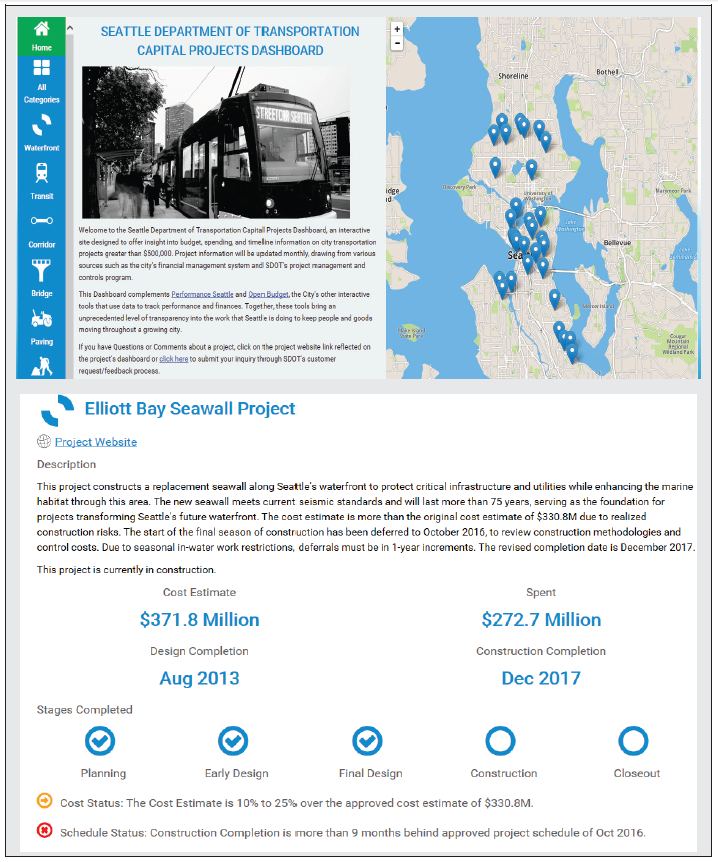
Source: https://capitalprojects.seattle.gov/#/, as at 22 January 2016.
Similar dashboards have also been developed for information and communications technology (ICT) projects in other jurisdictions, including the Queensland Government dashboard which monitors the progress of major ICT projects. VAGO's 2015 report Digital Dashboard: Status Review of ICT Projects and Initiatives applied this approach to ICT projects.
By providing this information, governments aim to improve project transparency and accountability, allow the public to compare projects using standardised metrics across agencies, and maintain and track project information over time. This can also inform government policy on the budgeting and management of capital projects.
1.4 Institutional arrangements and responsibilities
As indicated earlier:
- DTF and DPC advise the government on infrastructure investment and delivery
- DTF has also developed guidance for agencies to develop, procure, deliver and evaluate capital projects.
Although guidance is provided centrally, the government's devolved model of responsibility means that individual agencies are responsible for developing and successfully delivering infrastructure projects.
A range of public sector agencies routinely deliver major projects in Victoria. These agencies, and their typical projects, include:
- Department of Economic Development, Jobs, Transport & Resources (DEDJTR) through the following portfolio agencies:
- Public Transport Victoria—rail infrastructure and trains and trams
- Port of Melbourne Corporation—port infrastructure
- VicRoads—road building and upgrades
- Melbourne Metro Rail Authority—metropolitan rail project
- Level Crossing Removal Authority—removal of level crossing
- other—a variety of capital projects may also be delivered in agriculture, events and tourism and creative sectors
- Department of Justice & Regulation—prisons and police stations
- Court Services Victoria—courts and tribunals
- Department of Health & Human Services—new and upgraded hospitals and public housing
- Department of Environment, Land, Water & Planning and the Water Corporations—water infrastructure
- Department of Education & Training—schools.
Infrastructure Victoria, a new statutory authority, was established in September 2015 to provide independent and expert advice about Victoria's current and future infrastructure needs and priorities to support improved social, economic and environmental outcomes for the state. A key function of the new organisation is to develop a 30-year infrastructure strategy that identifies the state's infrastructure needs.
Projects Victoria, a new entity, when fully established, is expected to oversee the delivery of major capital projects, to research and develop appropriate delivery models and to review and improve capability in project development and delivery. It will also publicly report on the performance of all the projects it oversees.
1.5 Recent reviews of major infrastructure projects
1.5.1 Parliamentary inquiries
The Economy and Infrastructure Committee's 2015 First report into infrastructure projects examined five key infrastructure projects. It found that three of the projects that were currently underway—the Level Crossing Removal Program, the Western Distributor and the Melbourne Metro Rail Project—were still in the early stages, so business cases and detailed plans had not been finalised.
The committee concluded that the completion and release of the business cases and plans, including details on managing the disruption caused by these projects, the finalisation of funding arrangements and more precise cost estimates, was a key priority.
A 2012 Public Accounts and Estimates Committee Inquiry into Effective Decision‑Making for the Successful Delivery of Significant Infrastructure Projects examined six major infrastructure projects to identify lessons to inform decision-making and implementation of future infrastructure projects. The inquiry found that:
- poorly defined governance structures with unclear roles and responsibilities have hampered project management
- inadequate planning has led to significant delays, cost increases and failures to achieve original objectives
- overly ambitious and poorly scoped projects have unnecessarily heightened project complexity and risk.
1.5.2 Previous performance audits
Over the past six years,VAGO has tabled several audit reports that have considered the management, delivery and oversight of capital projects including:
- Management of Major Rail Projects, June 2010
- Construction of Police Stations and Courthouses, February 2011
- Management of Major Road Projects, June 2011
- Melbourne Markets Redevelopment, March 2012
- Managing Major Projects, October 2012
- Operating Water Infrastructure Using Public Private Partnerships, August 2013
- Impact of Increased Scrutiny of High Value High Risk Projects, June 2014
- Digital Dashboard: Status Review of ICT Projects and Initiatives, April 2015
- Operational Effectiveness of the myki Ticketing System, June 2015
- Applying the High Value High Risk Process to Unsolicited Proposals, August 2015
- East West Link Project, December 2015.
These VAGO reports have identified significant time and cost overruns in some projects, and recommended improvements to the way projects are developed and procured and to how outcomes are measured and reported. The audits have also identified poor business case development, including gaps in the information underpinning decisions, and the inadequate consideration of available procurement options as recurring shortcomings in government projects.
1.6 Audit objective and scope
The objective of the audit is to assess how effectively agencies manage the time, cost, scope, development and delivery of major capital projects by examining whether they have:
- developed business cases that provide a sound basis for the government to decide if, and in what form, investments should proceed
- developed sound procurement processes
- monitored and managed projects' progress and risks during delivery
- demonstrated that completed projects have achieved the intended outputs and outcomes.
The audit examined self-attested information from agencies and included a limited examination of key project documentation collected for a sample of 15 projects to verify its completeness and help focus future audits of major infrastructure projects. Specifically, the audit assessed whether the documents included content as required by the lifecycle guidelines and how well this material addressed the requirements.
The audit scope included Victorian public sector agencies responsible for managing capital projects with a TEI of $10 million or more, as listed in the 2015–16 State Capital Program Budget Paper.
This also included projects with a value of $10 million or more within programs that bring together multiple projects. Smaller capitals projects—less than $10 million—were excluded even if the program's TEI presented in the Budget Papers exceeded the $10 million threshold for the audit.

Construction underway to remove the level crossing at North Road in Ormond. Photograph courtesy of the Level Crossing Removal Authority.
1.7 Audit method and cost
In total, 33 agencies were asked to complete a survey and provide documentation detailing time, cost, development, delivery, governance, and performance information for each of their relevant capital projects.
Of these, two agencies attested that they did not have any projects that met our audit scope—RMIT University and the Metropolitan Fire and Emergency Services Board—and one—VicTrack—advised that although they are listed as the agency responsible for projects, these are being managed by other agencies.
The list of surveyed agencies is included in Appendix A. In addition, DPC was included given its role in advising the government on infrastructure investment and delivery.
Agencies were requested to provide an attestation that the information provided in their response was accurate and complete, to the best of their knowledge. Our summary of the self-attested information provided by agencies is set out in Part 2 of this report.
During the course of the audit, information submitted by agencies was in some instances clearly inaccurate.
A limited examination of supporting documentation for 15 projects, based on the size, sector and performance of projects, was undertaken to verify the documentation's completeness. Appendix B lists the capital projects selected for further review.
We have used DTF's lifecycle guidelines as a better practice guide and view the core components and requirements within the guidelines as essential and scalable across major projects.
The audit was conducted in accordance with the Australian Auditing and Assurance Standards. Pursuant to section 20(3) of the Audit Act 1994, unless otherwise indicated any persons named in this report are not the subject of adverse comment or opinion.
The cost of the audit was $495 000.
1.8 Structure of the report
This report has two further parts:
- Part 2 examines the survey responses provided by agencies relating to planning documents, governance structures, project management, procurement, post‑implementation reviews and project costs and time lines
- Part 3 examines the documentation collected for a selection of projects to verify its completeness and help focus future audits of major infrastructure projects.
2 Analysis of capital projects survey
At a glance
Background
The Department of Treasury & Finance's (DTF) Investment Lifecycle and High Value/High Risk Guidelines (lifecycle guidelines) provide guidance to agencies on managing projects. This part examines agencies' survey responses relating to planning, governance, project management, procurement, post-implementation reviews and project costs and time lines.
Conclusion
There is limited transparency on the status of major capital projects across the Victorian public sector, which means that Parliament and the public are restricted in their ability to access information on the progress of each project against cost and time targets.
The self-reported and attested information provided by agencies shows that a high proportion purport to prepare capital project documentation in line with the lifecycle guidelines and to have established appropriate governance and management structures.
Findings
- The vast majority of agencies reported compliance with DTF's lifecycle guidelines.
- Agencies identified a total of 251 projects within 2015–16 State Budget on 251 projects, with a total estimated investments (TEI) of $10 million or more, with a combined TEI of $35.7 billion.
- In total, 4 per cent of projects have already exceeded, or are forecast to exceed, their budgets by more than 5 per cent.
- Around one-third of projects are already late or are forecast to finish after their planned completion dates.
Recommendation
- That Department of Treasury & Finance and the Department of Premier & Cabinet advise government on how best to establish a public reporting mechanism that provides relevant project status information on capital projects costing $10 million or more, planned and actual costs, time lines, governance arrangements, and the extent to which benefits are realised.
2.1 Introduction
This part examines agencies' responses to the survey for capital projects over $10 million. After providing an overview in section 2.3, this part examines:
- planning documents, including business cases, procurement strategies and risk management, engagement and benefit management plans (section 2.4)
- procurement documents, including procurement and probity plans and tender evaluation reports (section 2.5)
- post-implementation reviews (section 2.6)
- governance and management structures (section 2.7)
- performance against budget and time lines (section 2.8).
2.2 Conclusion
There is limited transparency on the status of major capital projects across the Victorian public sector which means that Parliament and the public are restricted in their ability to access information on progress against cost and time targets.
The self-reported and attested information obtained through our survey indicates that a high proportion of agencies are preparing documentation in line with the lifecycle guidelines, including establishing appropriate governance and management structures. However, a significant number of projects are over budget and/or are late.
Obtaining current information on capital projects across the public sector is a complex and challenging exercise for many agencies. They found providing the information requested as part of this audit onerous and resource intensive due to:
- decentralised management and functions which require coordination across numerous units within the agency
- machinery-of-government changes
- some information, including business cases, being held by another agency.
Had agencies been applying regular high-level scrutiny to their investments, this information would have been readily available.
While the Department of Treasury & Finance (DTF) collects information on capital projects for presentation to government on a quarterly basis, there is an absence of detailed public reporting on a project-by-project basis. The transparency and oversight benefits of establishing a capital projects dashboard are significant.
2.3 Overview of results
2.3.1 Reported capital projects
The audited agencies identified a total of 251 projects within the 2015–16 Budget Papers as being above the $10 million threshold for this audit. These projects have a combined total estimated investment (TEI) of $35.7 billion, accounting for 69 per cent of the TEI for all capital projects in the State Budget. The remaining 31 per cent comprises:
- $2.3 billion worth of projects having a TEI of less than $10 million
- an estimated $14 billion in programs that bring together multiple smaller projects with individual TEIs of less than $10 million.
Figure 2A shows the number of projects and their reported TEIs by agency.
Five agencies—the Department of Economic Development, Jobs, Transport & Resources (DEDJTR), the Department of Health & Human Services (DHHS), Melbourne Water Corporation, Public Transport Victoria and VicRoads—account for around 69 per cent of projects, and 86 per cent of the combined TEI of $35.7 billion.
Figure 2A
Number of projects and their value by agency
Agency |
Number of projects |
Budget |
|---|---|---|
Barwon Water Corporation |
2 |
50.3 |
Bendigo Kangan Institute |
1 |
12.2 |
Central Gippsland Region Water Corporation |
1 |
40.4 |
Country Fire Authority |
3 |
36.3 |
Chisholm Institute |
1 |
70.5 |
City West Water Corporation |
2 |
310.9 |
Coliban Water Corporation |
3 |
63.1 |
Court Services Victoria |
2 |
79.0 |
Department of Economic Development, Jobs, Transport & Resources |
13 |
17 731.3(a) |
Department of Environment Land Water & Planning |
2 |
29.4 |
Department of Education & Training |
18 |
265.7 |
Department of Health & Human Services |
39 |
3 461.3 |
Department of Justice & Regulation |
16 |
680.5 |
Department of Treasury & Finance |
1 |
31.5 |
Goulburn Murray Rural Water Corporation |
2 |
932.8 |
Grampians Wimmera Mallee Water Corporation |
1 |
688.0 |
Lower Murray Urban & Rural Water Corporation |
1 |
119.8 |
Melbourne Water Corporation |
54 |
1 072.1(b) |
Places Victoria |
2 |
34.0 |
Port of Melbourne Corporation |
2 |
935.9 |
Public Transport Victoria |
38 |
4 282.3 |
Southern Metropolitan Cemeteries Trust |
1 |
53.4 |
South East Water Corporation |
4 |
275.6 |
South Gippsland Region Water Corporation |
1 |
20.0 |
Transport Accident Commission |
1 |
45.8 |
V/Line |
1 |
14.8 |
VicRoads |
28 |
4 051.3 |
Victoria Police |
4 |
54.6 |
Western Water Corporation |
2 |
63.7 |
Yarra Valley Water Corporation |
5 |
238.6 |
Total |
251 |
35 745.1 |
(a) This includes the Melbourne Metro Rail Project and the Level Crossing Removal Program which have a TEI range of $9–$11 billion and $5–$6 billion respectively and relates to funding for the full term of the projects. We have used the higher range of the estimate.
(b) The budgeted cost does not include 36 projects which are in the early planning stage and do not yet have a budget estimate.
Source: VAGO survey of 30 agencies, 2015.
2.3.2 Top 10 projects in terms of costs
Figure 2B shows the top 10 projects ranked by budgeted TEI where:
- transport projects account for 88.5 per cent of the top 10
- the top 10 projects account for 62.8 per cent of the TEI of all 251 reported projects.
Figure 2B
Top 10 capital projects by cost
Agency |
Project name |
Original cost ($ million) |
Forecast/ actual cost ($ million) |
Phase |
|---|---|---|---|---|
DEDJTR |
Melbourne Metro Rail Project |
9 000–11 000 |
9 000–11 000 |
Initiated |
Level Crossing Removal Program |
5 000–6 000 |
5 000–6 000 |
In delivery |
|
Port of Melbourne Corporation |
Port Capacity Project |
920.6 |
802.2 |
In delivery |
Goulburn Murray Rural Water Corporation |
Connections Program |
918.0 |
918.0 |
In delivery |
Public Transport Victoria |
Interim Rolling Stock |
817.1 |
782.7 |
Completed |
Grampians Wimmera Mallee Water Corporation |
Wimmera Mallee Pipeline Project |
688.0 |
657.5 |
Completed |
VicRoads |
Western Highway Duplication |
662.3 |
662.3 |
In delivery |
DHHS |
Victorian Comprehensive Cancer Centre |
501.5 |
501.5 |
In delivery |
Bendigo Hospital redevelopment |
473.0 |
129.5 |
In delivery |
|
Public Transport Victoria |
Tram Rolling Stock |
439.8 |
383.3 |
In delivery |
Source: VAGO survey of 30 agencies, 2015.
2.3.3 Capital project phases
Figure 2C shows that of the 251 capital projects reported:
- 47 (18.7 per cent) were at the initiation phase—detailed planning including research and project design/or development had commenced
- 46 (18.3 per cent) were at the approved phase—a business case had been approved
- 12 (4.8 per cent) were at the awarded phase—tendering process for the construction phase of the project had commenced and/or had been completed
- 100 (39.8 per cent) were in delivery—construction had commenced
- 40 (16 per cent) had been completed—project works were completed
- 5 (2 per cent) had been postponed—project was put on temporary hold
- 1 (0.4 per cent) had been terminated—project was terminated before completion and total expenditure has or will be written off.
Figure 2C
Number of capital projects by phase
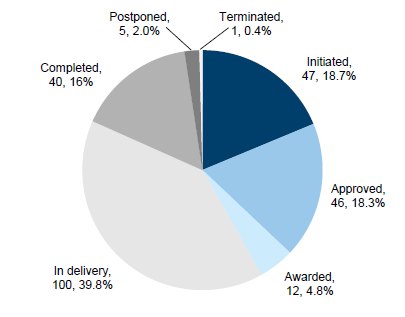
Source: VAGO survey of 30 agencies, 2015.
Figure 2D shows the cost of projects in each phase, with approximately half of the projects—in terms of cost ($17.2 billion)—being in delivery.
Figure 2D
Total budgeted project cost by phase, $ billion

Source: VAGO survey of 30 agencies, 2015.
Agencies reported that more than $256.7 million of capital projects were either terminated or postponed comprising:
- The Department of Justice & Regulation's (DJR) Infringement Management and Enforcement Services project, worth $24.9 million, was terminated in March2015, following significant difficulties and delays with the system build since 2007.
- Public Transport Victoria's Comeng Trains Life Extension project, worth $75 million, has been postponed pending the resolution of a safety issue significant for defining the project scope.
- DJR's Corrections System Expansion project, worth $65.1 million, was postponed. No reasons were provided—DJR stated that consideration through Cabinet was currently underway.
- DEDJTR's Port-Rail Shuttle–Metropolitan Intermodal System, worth $58 million, was postponed because it may not be the only way of achieving improved rail outcomes at the Port of Melbourne. The current government has decided to seek rail proposals as part of the Port of Melbourne lease.
- The Western Water Corporation's Surbiton Park winter storage project, worth $17.7 million, was postponed until further investigation of other projects that may provide greater cost efficiencies.
- Places Victoria's Harbour Esplanade Redevelopment Stage 2 Docklands project, worth $16 million, was postponed due to a revised project scope.
2.4 Planning documents
The lifecycle guidelines require all investment proposals over $10 million seeking Budget funding to submit a full business case which includes a:
- procurement strategy
- risk management plan
- stakeholder engagement and communication plan
- benefits management plan.
The level of technical detail required will vary depending on the size, scale and complexity of the investment.
Of the 251 projects, 47 were at the initiation stage and two were postponed while in the initiation stage, meaning they would not yet have business cases. Of the remaining 202 projects, well over 90 per cent had the relevant information within business cases or supporting plans, as shown in Figure 2E.
Figure 2E
Project planning documents
Document |
Document in place |
No document in place |
||
|---|---|---|---|---|
Number of projects |
Percentage of all projects |
Number of projects |
Percentage of all projects |
|
Business case |
197 |
97.5 |
5 |
2.5 |
Procurement strategy |
195 |
96.5 |
7 |
3.5 |
Risk management plan |
201 |
99.5 |
1 |
0.5 |
Stakeholder engagement plan |
191 |
94.6 |
11 |
5.4 |
Benefits management plan |
192 |
95.0 |
10 |
5.0 |
Source: VAGO survey of 30 agencies, 2015.
Planning documents were prepared for all projects except the Level Crossing Removal Program. The government committed to remove 50 specific level crossings and the overall business case is currently being prepared for completion in mid-2016.
The works to remove level crossings are proceeding, with the first crossings having individual, business cases or project proposals covering, among other things, the key technical elements and deliverability information required in a business case.
However, proceeding with this program without an overall business case is not recommended practice and raises the risks around the timely and efficient delivery of the intended benefits. Precise cost and benefit estimates for the program have not yet been prepared and validated.
DTF and the Department of Premier & Cabinet (DPC) advice to government, in June 2015, noted the challenge in delivering the entire Level Crossing Removal Program within the $5–$6 billion commitment. Given the significant expenditure and risks in delivering such a large program, it is critical that a comprehensive program business case is completed and that it adequately considers the costs, benefits and risks together with an options analysis to assure government that the preferred approach represents good value.
2.4.1 Business cases
The lifecycle guidelines require a full business case to set out the problem, intended benefits, strategic options and recommended solution. The level of technical detail required will vary depending on the size, scale and complexity of the project.
Figure 2F shows that agencies attested that a business case was developed for 197 of the 202 projects (around 97.5 per cent) and that for 184 (93 per cent) business cases included all the required elements.
Figure 2F
Development of business cases
Agency response |
Business case developed |
Contains all required elements |
||
|---|---|---|---|---|
Number of projects |
Percentage of all projects |
Number of projects |
Percentage of all projects |
|
Yes |
197 |
97.5 |
184 |
93 |
No |
5 |
2.5 |
13 |
7 |
Total |
202 |
100 |
197 |
100 |
Source: VAGO survey of 30 agencies, 2015.
One problem agencies encountered was difficulty in accessing businesses cases. This affected 66 of the 197 projects for which business cases had been prepared. Agencies advised VAGO to obtain these Cabinet-in-Confidence documents from DPC because:
- 49 had been surrendered to DPC on the change of government and agencies no longer had access to these documents
- for the remaining 17, agencies were unsure whether the versions held were the same as the final documents presented to government.
DPC quickly identified and provided 30 of these documents. However, locating the remaining 36 business cases proved very difficult and after an extensive search, DPC:
- provided a further 21 cases where agencies had not initially provided sufficient information to locate the documents—for example, where the project was part of the business case for a wider initiative
- identified four projects as not being covered by standalone business cases because they had been identified within a high-level plan—for example, the 'Tram procurement project' was only presented as part of the 'Victorian Transport Plan'
- confirmed that for two projects, the relevant departments (DHHS and DJR) held this documentation and it had not been submitted to Cabinet or a Cabinet committee
- could not find nine business cases that had been recorded as part of a single submission for a former government's budget review process.
The difficulties DPC encountered in providing access to 36 of the 66 business cases were due mainly to agencies providing insufficient or inaccurate information about the project title or whether it was part of the business case for a wider program. Agencies did not use the index information they would have provided in surrendering these documents to DPC—this is a records management failure they need to address.
DPC could not find nine of these business cases that were recorded as being submitted to Cabinet. This is DPC's responsibility, but the department has advised that changes in its process for the filing and auditing of cabinet and committee records mean this issue is now unlikely to be repeated.
Five of the 202 projects, with budgeted costs of up to $6 billion, did not have or could not provide a business case, as shown in Figure 2G.
Figure 2G
Projects without a business case
Agency |
Project |
Budgeted cost |
Reason for no business case |
|---|---|---|---|
DEDJTR |
Level Crossing Removal Program |
5 000–6 000 |
VicRoads and DEDJTR have prepared business cases or project proposals for four packages of works comprising 19 crossings in advance of a business case for all 50 level crossings. |
DEDJTR |
Parkville Gardens |
43.5 |
DEDJTR advised that this is a legacy project from the 20 per cent social housing mandate as part of the delivery of the Commonwealth Games Village, entered into in December 2003, and that it was covered in a former department's Commonwealth Games Budget submission in 2003.However, DEDJTR could not find this submission in its records. |
DHHS |
Simonds Stadium redevelopment—Stage 4 |
75.0 |
The project was originally an output funding submission that subsequently became a capital‑funded project. As a result, a full business case was not prepared. |
DJR |
Corrections systems expansion—emergency beds program |
19.5 |
In early 2014, a spike in prisoner numbers created a pressing need for additional prison beds. This urgent need for 300 emergency beds across the prison system was supported and funded by government. Given the time-sensitive nature of this project, DJR decided to forgo the development of a comprehensive business case. |
Victoria Police |
Victoria Police Mounted Branch Relocation |
11.9 |
Victoria Police advised that the business case was a DPC-led initiative because the Victoria Police Mounted Branch was required to be relocated so the site could be redeveloped by Arts Victoria. This is not a valid reason for not developing a business case. |
Source: VAGO survey of 30 agencies, 2015.
Review of business cases
The lifecycle guidelines indicate that business cases should be regularly reviewed by agencies or project managers to reflect significant changes to the project environment and provide an up-to-date case for the project throughout its life. However, Figure 2H shows that only 65 of business cases (33 per cent) were reviewed after approval.
Figure 2H
Review of business cases
Agency response |
Business case reviewed |
|
|---|---|---|
Number of projects |
Percentage of projects |
|
Yes |
65 |
33 |
No |
132 |
67 |
Total |
197 |
100 |
Source: VAGO survey of 30 agencies, 2015.
This lack of review after approval risks the business case becoming a static document used for funding but not updated and used for driving and managing the intended project outcomes.
2.4.2 Procurement strategies
Choosing the right procurement model is a significant decision requiring in-depth analysis and consideration. Getting it wrong could have a serious impact on the project delivery and realisation of benefits. The business case should include a procurement strategy analysing options and making recommendations on the preferred procurement method to inform the project approval and funding decision.
Agency responses indicate that a procurement strategy was developed for 195 of the 202 capital projects reported (96.5 per cent). The seven projects shown in Figure 2I, with a cumulative cost of $187 million, did not have such a strategy.
Figure 2I
Projects without a procurement strategy
Agency |
Project |
Budgeted cost ($ million) |
Reason for no procurement strategy |
|---|---|---|---|
DEDJTR |
Parkville Gardens |
43.5 |
See comments in Figure 2G. |
DJR |
Expanding Community Correctional Services |
25.9 |
Procurement conducted through the shared service provider within DTF that undertakes property searches, leasing arrangements and fit-out services on behalf of government departments. This is not a competitive process. DJR advised that, therefore, no procurement strategy was required. |
DJR |
Fines Reform Information and Communications Technology (ICT) Project |
15.0 |
This project was merged into another project for which a procurement strategy was developed. |
DJR |
Mobile Camera Replacement Program |
17.1 |
DJR advised that a procurement strategy will be developed upon completion of the proof of concept stage of the project. |
VicRoads |
Geelong-Bacchus Marsh Road |
27.0 |
VicRoads advised that these three projects are currently at an early stage of development, with procurement strategies currently being developed. |
Goulburn Valley Highway—Molesworth to Yea |
18.5 |
||
Hume Freeway—Continuous Wire Rope Safety Barrier |
40.0 |
Source: VAGO survey of 30 agencies, 2015.
2.4.3 Risk management plans
A risk management plan—usually included in the business case—identifies, assesses, prioritises and describes how to mitigate project risks.
Agency responses indicate that a risk management plan was developed for 201 of the 202 capital projects reported (99.5 per cent). The Corrections system expansion—emergency beds program, with a budgeted value of $19.5 million, did not have a risk management plan.
2.4.4 Stakeholder engagement and communication plans
A stakeholder engagement plan identifies, assesses and prioritises key stakeholder groups to ensure that they are effectively engaged throughout the project.
Agency responses indicate that a stakeholder engagement and communication plan was developed for 191 of the 202 capital projects reported (94.6 per cent). The 11 projects shown in Figure 2J, with a cumulative cost of $479.4 million, did not have stakeholder engagement and communication plans.
Figure 2J
Projects without a stakeholder engagement and communication plan
Agency |
Project |
Budgeted cost ($ million) |
Reason for no stakeholder engagement and communication plan |
|---|---|---|---|
DELWP |
More effective support for strategic fuel management |
16.8 |
A specific stakeholder engagement and communication plan was not developed. However, internal and external stakeholders were regularly consulted to ensure effective design and interoperability with other agencies. |
DJR |
Corrections system expansion—emergency beds program |
19.5 |
See comments in Figure 2G. However, DJR advised various stakeholder engagement and communications activities did occur. |
DJR
|
Barwon High Security Unit |
35.0 |
Stakeholder engagement and management forms part of the project governance forums. |
DJR |
Critical infrastructure and services—Barwon Waste Water Treatment Plant |
17.0 |
Stakeholder engagement and management forms part of the project governance forums. |
DJR |
Critical infrastructure and services—Melbourne Assessment Prison Reception |
11.8 |
Stakeholder engagement and management forms part of the project governance forums. |
DJR |
Karreenga Annexe—Marngoneet |
79.6 |
Stakeholder engagement and management forms part of the project governance forums. |
DJR |
Middleton Annexe—Loddon prison |
79.0 |
Stakeholder engagement and management forms part of the project governance forums. |
DJR
|
State Coronial Services Centre |
113.0 |
Stakeholder engagement and management forms part of the project governance forums. |
DJR |
Women's prison expansion strategy—Dame Phyllis Frost Centre Mental Health Unit |
40.7 |
Stakeholder engagement and management forms part of the project governance forums. |
VicRoads |
Geelong-Bacchus Marsh Road |
27.0 |
VicRoads advised that these two projects are currently at an early stage of development, with stakeholder engagement and communication plans currently being developed. |
Hume Freeway—Continuous Wire Rope Safety Barrier |
40.0 |
Source: VAGO survey of 30 agencies, 2015.
2.4.5 Benefits management plan
Investments in capital projects are intended to provide benefits to the state and community. Projects are only valuable if they deliver these benefits. A benefits management plan sets out how benefits defined in the business case are going to be monitored, evaluated and reported.
Responses show that benefits management plans were in place for 192 of the 202 projects reported (95 per cent). However, as highlighted in Figure 2K, 10 projects (5 per cent), cumulatively valued at around $288.5 million, did not have a benefits management plan.
Further, benefits management plans were reported as being reviewed for only 24 of the 35 projects where there were changes in the project scope, costs or time lines after the business case was approved. It is important that benefits management plans are live, up-to-date documents that reflect changes in project scope.
Figure 2K
Projects without benefits management plan
Agency |
Project |
Budgeted cost ($ million) |
Reason for no benefits management plan |
|---|---|---|---|
Barwon Water |
Black Rock Water Reclamation Plant Inlet Hydraulic Capacity Upgrade |
14.3 |
Barwon Water considers that the cost benefit in the business case analysis serves the same purpose as a benefits management plan. This is not consistent with the lifecycle guidelines which require a separately documented benefits management plan. |
Coliban Water |
Rochester to Echuca Water Reclamation Plant |
10.0 |
Benefits management plan not required when business case prepared in late 1990s. |
DEDJTR |
Parkville Gardens |
43.5 |
See comments in Figure 2G. |
DHHS |
Westmeadows Redevelopment—144 units/sites |
71.8 |
No reason provided. |
DJR |
Corrections system expansion—emergency beds program |
19.5 |
See comments in Figure 2G. |
DJR |
Hopkins Correctional Centre Expansion Project |
45.9 |
No reason provided. |
Victoria Police |
Victoria Police Mounted Branch Relocation |
11.9 |
Victoria Police advised that it did not develop a business case including a benefits management plan because the relocation was driven by a DPC-led initiative to expand the Victorian College of the Arts to the South Melbourne site. This is not a valid reason for not developing a business case and benefits management plan. |
Yarra Valley Water |
Aurora Waste to Energy Facility |
27.1 |
Yarra Valley Water advised that a benefits management plan will be developed for the project as part of the transition from construction to operation. |
Donvale Backlog Sewerage —Package C |
22.5 |
Yarra Valley Water advised that a benefits management plan was not prepared because benefit tracking is embedded within standard business processes. |
|
Wallan Sewerage Treatment Plant Upgrade |
22.0 |
Yarra Valley Water advised that a benefits management plan was not developed. that the projects' key benefits will be tracked through operational performance tracking indicators e.g. volume of sewerage treated, quality of effluent produced, volume of water recycled etc. |
Source: VAGO survey of 30 agencies, 2015.
2.5 Procurement processes
It is important that procurement for large capital projects is well conducted given the significant expenditure involved and the impact it can have on delivering government programs and services and on the achievement of the intended outcomes.
Agencies are required to develop a procurement plan after funding has been approved. This is a key product of the procurement stage of the investment lifecycle, providing guidance about the expression of interest, tendering and contract negotiation phases and how to effectively manage probity and procurement risks.
A probity plan is required for all major projects exceeding $10 million and also for other projects assessed as complex or high risk.
Upon completion of the procurement activities, the results of the tender evaluation process must be comprehensively documented in a final report.
Figure 2L shows which documents were in place for the 155 projects that undertook procurement.
Figure 2L
Procurement documents
Document |
Document in place |
No document in place |
||
|---|---|---|---|---|
Number of projects |
Percentage of all projects |
Number of projects |
Percentage of all projects |
|
Procurement plan |
131 |
85 |
24 |
15 |
Probity plan |
117 |
75 |
38 |
25 |
Tender evaluation report |
140 |
90 |
15 |
10 |
Source: VAGO survey of 30 agencies, 2015.
Agencies reported the following:
- A procurement plan had been prepared for 131 of the 155 projects (around 85 per cent)
- A probity plan had been prepared for 117 of the 155 projects (around 75 per cent). This means that 38 projects, valued at $1.64 billion, did not have a probity plan as required under the lifecycle guidelines. Without a probity plan, it is unclear how agencies manage probity risks including managing tender communications, late tenders, tender security and confidentiality, intellectual property, etc.
- A tender evaluation report had been prepared for 140 of the 155 projects (90 per cent). Fifteen projects had not prepared such a report, and this is a significant omission because there is no documented explanation of the reason for selecting a preferred tenderer.
From a project perspective, Figure 2M shows that of the 155 procured projects:
- 104, or two-thirds, had all the required documentation
- 28 had two of the three required documents
- 20 reported having one of the three required documents.
The following three projects, with a budgeted cost of $83 million, reported having no procurement plan, probity plan or tender evaluation report:
- Cardinia Road Station, managed by Public Transport Victoria.
- Corrections system expansion—emergency beds program, managed by DJR.DJR received ministerial approval for the procurement of emergency beds in response to the urgent demand for additional prison beds across the prison system.
- Expanding Community Correctional Services, managed by DJR.
Figure 2M
Project procurement documentation

Source: VAGO survey of 30 agencies, 2015.
2.6 Post-implementation reviews
Realising the benefits of an investment is the important final stage of an investment's lifecycle. The key is to develop a benefits management plan at the start, to make it possible to track, report, validate and evaluate the delivery of the expected benefits. It also involves conducting a post-implementation review to find out whether the expected benefits of the investment have been realised, and what lessons can be learned from the project for both current and future projects.
Agencies indicated that 12 of 41 completed and terminated projects (29 per cent) had undertaken post-implementation reviews. Of the remaining 29 completed projects:
- 28 had yet to commence the post-implementation review but agencies advised that they planned to do so
- one project, Middleton Annexe—Loddon Prison, managed by DJR, with an estimated cost of $79 million, did not do a post-implementation review.
2.7 Governance and management structures
Project governance and management structures should be in place throughout the life of a project. They set the framework for transparency, provide assurance about the way decisions are made and clarify roles and responsibilities.
Survey responses indicate that all 202 reported capital projects had established a defined governance structure. This excludes 47 projects at the initiation stage and two projects that were postponed in the initiation stage, as they do not have approved business cases setting out governance and management structures.
A robust project management methodology is required to guide the project to deliver its intended investment benefits.
A commonly cited reason for project failures is poor project management. Therefore, applying a formalised project management methodology can help to clarify goals, identify resources needed, ensure accountability for results and performance, and foster a focus on the intended benefits.
Of the capital projects report, 198 (98 per cent) were managed using recognised project management methodologies or the agencies' own project management methodologies. Of the 198 projects:
- 4 per cent used Project Management Body of Knowledge (PMBoK)
- 3 per cent used PRINCE2
- 85 per cent used their own in-house methodology
- 8 per cent used other recognised methodologies.
Given the large proportion of agencies using their own project management methodologies, future audits of capital projects will examine the adequacy of these methodologies.
2.8 Performance against budget and time lines
Cost and time variances are important because they defer the realisation of intended project benefits and may require government to divert funds from other activities. If large enough, they can undermine the completion of projects and lead to their cancellation.
2.8.1 Actual versus budgeted cost
The agencies reported costs for 215 of the 251 projects. No budget or actual figures were provided for 36 projects because they had only recently been initiated. The total reported cost for the 215 projects was $35.7 billion, which is around $0.74 billion less than the approved budget estimates.
While this represents an overall budget saving, the reality is masked by the 55 projects which are, or are expected to be, completed $1.2 billion under budget.
Figure 2N shows the percentage of projects on, over or under their approved budget.
Figure 2N
Percentage of projects on, over or under budget

Source: VAGO survey of 30 agencies, 2015.
Eight projects are or are expected to be over their approved budget by over 5 per cent. As shown in Figure 2O, these projects had a total cost of $379.9 million, meaning they are or are expected to be $47.6 million (14.3 per cent) over the total budgeted cost of $332.2 million. Agencies identified that the main factors contributing to cost overruns were design and/or scope changes.
Figure 2O
Projects over approved budget
Agency |
Project |
Phase |
Budget ($ million) |
Actual ($ million) |
Per cent over budget |
|---|---|---|---|---|---|
Melbourne Water Corporation |
Dandenong Creek Wetland |
Completed |
19.7 |
35.4 |
80.1 |
Country Fire Authority |
Dandenong Fire Station |
Completed |
10.7 |
12.9 |
20.2 |
Public Transport Victoria |
Lynbrook Station |
Completed |
28.6 |
33.0 |
15.4 |
City West Water Corporation |
The Arrow Program |
In delivery |
106.0 |
119.6 |
12.8 |
Coliban Water Corporation |
Rural System Reconfiguration—Harcourt |
In delivery |
39.5 |
42.6 |
7.8 |
South East Water Corporation |
Frankston Head Office Construction |
In delivery |
91.6 |
98.1 |
7.1 |
VicRoads |
High Street Road Improvement Project |
In delivery |
16.2 |
17.2 |
6.2 |
Melbourne Water Corporation |
Asset Management Information System—AMIS |
Completed |
19.9 |
21.0 |
5.6 |
Total |
332.2 |
379.8 |
14.3 |
||
Source: VAGO survey of 30 agencies, 2015.
Of the projects that are over budget:
- Four (50 per cent) are over budget by more than 10 per cent, or $35.9 million across all projects.
- Four (50 per cent) are over budget by less than 10 per cent, or $11.7 million across all projects.
In addition to the eight projects in Figure 2O, there were a further six projects more than 5 per cent over their original budget. These projects, with a combined original budget value of $937.7 million, have received additional funding of $270.7 million following approved project scope changes. These projects include:
- Geelong Hospital major upgrade—original budget $93.3 million, revised budget $118.2 million
- Barwon Health—original budget $28.1 million, revised budget $33.1 million
- Box Hill hospital redevelopment—original budget $407.5 million, revised budget $447.5 million
- Bayside Rail Improvement project—original budget $100 million, revised budget $115 million
- Regional Fast Rail Passenger Information Display—original budget $8.8 million, revised budget $10.2 million
- Melbourne Market Relocation Project—original budget $300 million, revised budget $484.4 million.
For some projects the scope changes and associated budget revisions raise questions about whether the basis for the original investment decisions was sound. For example, the Melbourne Market Relocation Project had an original approved budget of $300 million for the purchase of a suitable site and construction of the trading floor and associated infrastructure. No funding was provided for warehousing or other site development. This budget was later revised in April 2009 and June 2011 to $484.4 million due to:
- the addition of warehousing, which was originally to be financed by a private company, with costs recovered through rental or sale to market tenants and users
- $116 million in additional costs for land purchases and construction
- $65 million for site preparation and project management costs which had been omitted from the original budget.
While the final forecast TEI for this project of $438.2 million represents an expected saving of $46.2 million against the revised budget, the need to revise the budget indicates that the project was not adequately costed prior to seeking funding. VAGO's 2012 audit Melbourne Markets Redevelopment found that the business case was deficient in relation to project costing and time frame.
Appendix C provides a snapshot of reported and approved budgeted costs for all projects.
2.8.2 Actual versus planned time lines
Agencies reported the time lines for 212 of the 251 projects, because 39 projects were in early planning and milestone dates had yet to be determined. Figure 2P shows that half the projects were completed, or forecast to be completed, on time and 17 per cent (37 projects) were delivered early.
Figure 2P
Percentage of projects completed, or forecast to be completed,
early, on time and over time
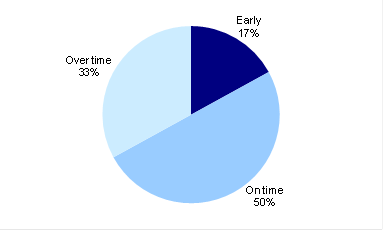
Source: VAGO survey of 30 agencies, 2015.
The 70 projects which are or are likely to be late have a budgeted cost of around $5.5 billion, or more than 14 per cent of the total budgeted cost. Figure 2Q shows the time variation of these 70 projects.
Figure 2Q
Projects over time

Source: VAGO survey of 30 agencies, 2015.
Of these projects, almost one-third are more than two years late, as listed in Figure 2R.
Figure 2R
Projects over two years late
Agency |
Project |
Time over |
|---|---|---|
DEDJTR |
Melbourne Market Relocation Project |
7 years 8 months |
Public Transport Victoria |
Regional Fast Rail Passenger Information Displays |
4 years 6 months |
City West Water Corporation |
The Arrow Program |
4 years 0 months |
West Werribee Dual Water Supply Scheme |
3 years 9 months |
|
Melbourne Water |
Aeration Tanks—additional aeration tanks |
3 years 7 months |
Coliban Water Corporation |
Echuca and Cohuna taste, toxin and odour |
3 years 5 months |
Public Transport Victoria |
Replacement of Electrol SCADA System |
3 years 3 months |
VicRoads |
Princes Highway East—Traralgon to Sale duplication |
3 years 3 months |
Public Transport Victoria |
Tram Automatic Vehicle Monitoring System Replacement |
3 years 2 months |
VicRoads |
Western Highway Improvements – Stawell to SA Border |
3 years 0 months |
DHHS |
Efficient Government Building (statewide) |
3 years 0 months |
Public Transport Victoria |
Caroline Springs Station |
2 years 11 months |
DEDJTR |
Frankston Station Precinct Redevelopment |
2 years 11 months |
Public Transport Victoria |
Route 96 |
2 years 9 months |
Places Victoria |
Harbour Esplanade Redevelopment Stage 2 (Docklands) |
2 years 6 months |
DJR |
State Coronial Services Centre |
2 years 4 months |
Hopkins Correctional Centre Expansion Project |
2 years 3 months |
|
DELWP |
More Effective Support for Strategic Fuel Management |
2 years 2 months |
DHHS |
Carlton redevelopment – 246 units/sites (Carlton) |
2 years 0 months |
Norlane Redevelopment – 164 units/sites |
2 years 0 months |
|
Westmeadows Redevelopment – 144 units/sites |
2 years 0 months |
Source: VAGO survey of 30 agencies, 2015.
Similar to projects being over budget, the main reason given for time delays is scope changes. For example:
- Places Victoria advised that the original scope of the Harbour Esplanade Redevelopment Stage 2 was to prepare the waterfront for future development. A decision was made to revisit the scope of Stage 2 after achieving the first key outcome of demolishing the four dilapidated wharves. The project was then paused to review opportunities to deliver a better-quality outcome and extend the scope of the works. Places Victoria consulted with stakeholders, prepared the required revised business case and submitted it to the Treasurer for approval.
- VicRoads advised that the Western Highway Improvements—Stawell to SA Border project is late due to land acquisition and changes in scope.
Agencies noted several other reasons that contributed to time delays. For example:
- VicRoads advised that that the Princes Highway East—Traralgon to Sale Duplication project is late because the construction was delayed until planning and environmental matters were resolved.
- DELWP advised that the delay in delivering the More Effective Support for Strategic Fuel Management project occurred during the procurement phase. The initial tender responses failed to meet the relevant criteria and, as such, DELWP’s specifications were revisited and redeveloped prior to a further approach to the market. This had a roll-on effect on the final delivery of the project.
Appendix C provides a snapshot of the performance of all the reported projects against planned time lines.
Recommendation
- That the Department of Treasury & Finance and the Department of Premier & Cabinet advise government on how best to establish a public reporting mechanism that provides relevant project status information on capital projects costing $10 million or more, planned and actual costs, time lines, governance arrangements, and the extent to which benefits are realised.
3 Review of supporting documentation
At a glance
Background
This part shows the results of a limited examination of the key project documentation, collected for a sample of 15 of the 251 projects, to verify its completeness and consistency with Department of Treasury & Finance's (DTF) Investment Lifecycle and High Value/High Risk Guidelines(lifecycle guidelines).
Conclusion
Agencies are clearly using DTF's lifecycle guidelines templates to structure their project documentation. While this is encouraging, in about half of the documentation reviewed there were significant gaps or weaknesses in the content used to populate these templates.
Agencies need to improve on this because fully addressing the lifecycle guidelines is critical if they are to comprehensively identify and manage the risks to the delivery of intended benefits on time and within approved budgets.
Findings
- For 12 of the 15 projects examined (three could not provide planning documentation), the documentation adequately addressed 50 per cent of the key planning elements and 40 per cent of the procurement elements of the lifecycle guidelines.
- Defining the problem and explaining the strategic option analysis appear to be the strongest elements. The areas of most concern are in describing the benefits, documenting the solution option analysis, proving the deliverability and identifying and managing probity risks.
Recommendations
- That agencies implement a documented and consistent approach to verify that they have adequately addressed the requirements of the Department of Treasury & Finance’s lifecycle guidelines for government-funded capital projects.
- That the Department of Treasury & Finance periodically reviews agencies’ performance in applying the lifecycle guidelines for projects costing $10 million or more and provides feedback to agencies on areas requiring improvement.
3.1 Introduction
This part includes a limited examination of the documentation collected for a sample of 15 of the 251 projects included in the audit, to verify its completeness and help focus future audits of major infrastructure projects.
This involved assessing whether the documents included content as required by the Department of Treasury & Finance's (DTF) Investment Lifecycle and High Value/High Risk Guidelines (lifecycle guidelines) and a limited analysis of how well this material addressed the requirements. We assessed whether it substantially met, partly met or clearly did not meet the lifecycle guidelines' requirements.
Typically, in conducting an audit focused on a small number of projects, we would increase the level of assurance through a more extensive analysis and by engaging each agency to confirm our assessment and resolve any outstanding issues. The scope and objectives of this audit mean we did not do this, but instead focused on those areas where the documentation clearly fell short of the requirements.
Our results are sufficient to identify these areas for future scrutiny and they are also consistent with the findings of recent VAGO infrastructure audits.
In this part, we assess:
- planning documentation, comprising material normally expected to be provided in the business case describing the problem, solution options, benefits, the procurement strategy, risk management, stakeholder engagement and benefits management plans, and the governance and project management arrangements
- procurement documentation(when a project moves beyond approval to procurement),comprising procurement and probity plans and tender evaluation reports
- post-implementation reviews and benefits realisation for completed projects.
3.2 Conclusion
Agencies are clearly using the lifecycle guidelines templates to structure their project documentation. While this is encouraging, there are significant gaps or weaknesses in the content used to populate these templates in about half of the documentation reviewed.
Agencies need to improve on this because fully addressing the lifecycle guidelines is critical if they are to comprehensively identify and manage the risks to the delivery of intended benefits on time and within approved budgets.
3.3 Planning
3.3.1 Overview of the business cases provided
A robust and comprehensive business case is critical to the success of an investment, and the lifecycle guidelines require this documentation to:
- clearly demonstrate the problem to be addressed
- adequately support and demonstrate the benefits of the proposal
- sufficiently explore options to respond to the problem and deliver benefits
- assess and evaluate a range of options from a socioeconomic, financial and risk perspective
- prove the deliverability of the recommended solution, including a procurement strategy, risk management, stakeholder engagement and benefits management plans, and governance and project management arrangements.
- Agencies were unable to provide a business case or equivalent documentation for three of the 15 projects:
- The Level Crossing Removal Program was committed to, but does not have, a business case or equivalent documentation. The Department of Economic Development, Jobs, Transport & Resources (DEDJTR)advised us that VicRoads had previously prepared business cases for eight level crossing removals that were to be delivered as individual projects. These projects have been combined into packages of works and now form part of the larger program. A business case for the overall program is under development, and DEDJTR anticipates that it will be submitted to government in mid-2016.
- For two projects—Regional Fast Rail Passenger Information Displays and Lynbrook Station—Public Transport Victoria (PTV) could not provide business cases because these had been put in secure storage as part of a submission of the former government's budget review process. Our follow-up inquiries to the Department of Premier & Cabinet (DPC) have been unsuccessful in locating and accessing these documents. In response to our survey, PTV attested that these two projects have a business case. This is a significant records management failing.
For all three projects the absence of this documentation is a significant issue and means we have been unable to assess if they covered key elements contained in the investment lifecycle guidelines.
For the Level Crossing Removal Program although the works tendered to date have either had individual business cases or project proposals, the absence of a business case for the whole program before the commencement of delivery means that the total cost or benefits are currently unknown.
Most departments included in the audit identified project-related Cabinet-in-Confidence material that had been surrendered on the change of government which they understood they could no longer access.
This was also raised as an issue in VAGO's 2015 audit Operational Effectiveness of the myki Ticketing System where DTF informed VAGO of the constraints in accessing the myki business case as it was a Cabinet document of the former government.
DTF has maintained this position during this audit and pointed to its advice to the Treasurer on options for, and the implications of, increasing the public disclosure and internal retention of infrastructure business case information beyond a single government term.
However, DPC has confirmed that under current Cabinet conventions, agencies may apply to retain access to this type of documentation or apply for access to surrendered Cabinet-in-Confidence documentation.
DPC provided evidence in the form of:
- advice circulated to departments in October 2014 advising how to apply to exempt Cabinet-in-Confidence documents from being surrendered during the caretaker period if they relate to ongoing department business or a current or proposed project
- examples of agencies requesting access to Cabinet-in-Confidence material from past governments because it was needed to undertake a review.
Given this, it is clear that mechanisms exist which enable agencies to retain or obtain access to Cabinet-in-Confidence material where justified that it relates to ongoing business. However, this is not comprehensively understood across all public sector agencies.
Review of business case documentation
Figure 3A summarises the results of our assessment of business case documentation for the 12 projects covering the key elements defined in the lifecycle guidelines—defining the problem, the expected benefits, the analysis of strategic options, the more in-depth analysis of the preferred solution, and the proof that this solution is deliverable.
We chose a range of projects that had progressed at least to implementation, that covered different portfolios and that ranged in cost. The assessment considered the project cost in framing expectations about the quantity of information and analysis provided.
Figure 3A
Assessment of key elements of the business case
|
Key elements of the business cases |
Number of projects |
||
|---|---|---|---|
|
Substantially met |
Partly met |
Not met |
|
|
Problem—definition and evidence of the problem |
9 |
1 |
2 |
|
Benefits—outline of the benefits to be delivered and measures to show how they will be delivered |
5 |
4 |
3 |
|
Strategic options analysis—exploration of options to respond to the problem and deliver benefits |
7 |
2 |
3 |
|
Solution option analysis—evaluation of a range of options from a socioeconomic, financial and risk perspective |
3 |
5 |
4 |
|
Prove the deliverability—rationale for recommended solution |
6 |
1 |
5 |
Note: Substantially met—adequately addressing requirements. Partly met—partially addressing requirements with identifiable gaps. Not met—weaknesses mean the documentation is likely to fall short of the minimum required.
Source: VAGO.
For the 12 projects with a business case, only 50 per cent of the lifecycle guidelines' key elements were substantially met. Although these results suggest that agencies are following the lifecycle guidelines templates and are doing this well half the time, gaps or weaknesses in 50 per cent of key business case elements is too high.
The areas of most concern are in describing the benefits, documenting the solution, option analysis and proving deliverability. Defining the problem and explaining the strategic option analysis appear the strongest elements.
The remainder of this section provides more detailed findings for each element.
3.3.2 Defining the problem
Nine of the 12 projects assessed adequately described the problems driving the need for the investment and provided relevant, quantitative evidence to support it.
However, two projects clearly fell short of the lifecycle guidelines requirements in not providing sufficient information to adequately:
- understand the nature and extent of the problems
- quantify the problems, including details of demand forecasts or current performance levels, in order to set a base for measuring the project's success.
For example, the business case for one of the projects assessed as not having met the requirements provided little detail or analysis of the problem. The key focus was on the government's commitment to deliver the project.
The business case for the project that was assessed as partly having met the requirements adequately defined some problems but identified the delivery of the project in accordance with government policy as the main focus. While the investment clearly addressed a government policy commitment, this was not the problem that needed to be addressed.
3.3.3 Describing the benefits and their measurement
Being clear about a project's outcomes by defining tangible benefits and how these will be practically measured is critical if a project is to meet expectations.
Seven of the 12 assessed projects, or more than half, had not adequately defined the benefits or appropriate performance measures of success:
- for one project,the agency had defined no performance measures and did not demonstrate that it understood the intended outcomes for the project
- for five projects, agencies had not documented baseline data and performance targets to demonstrate a clear understanding of the benefits and a credible plan for their delivery
- for three projects, benefits and measures were defined but they were not articulated in measurable terms. In one business case, a key benefit measure was delivery on time, without any measures to assess the service impacts of the investment.
These shortcomings mean that for just over half the projects, agencies are unlikely to be able to track and understand whether the intended benefits are being achieved. In VAGO's audits on capital projects over the past decade, the absence of a considered and structured approach to defining and evaluating benefits has been a consistent theme.
3.3.4 Strategic options analysis
The business case needs to explore a reasonable spread of potential, viable options to address the intended problem.
Seven of the 12 projects had business cases which demonstrated that various strategic options had been considered
However the business cases for five projects fell short of doing this:
- For two projects, the rationale for the recommended option was not clearly explained. Both considered and ranked options, but they failed to justify the preferred option in terms of a comparison of costs, benefits and risks.
- For three projects, the consideration of strategic options had been significantly constrained, largely due to government commitment in advance of the business case preparation.
Committing to a particular strategic option before conducting the type of analysis needed to justify a project does not avoid the need to clearly illustrate the comparative costs, benefits and risks of all realistic and viable options. Agencies are responsible for adequately informing decision-makers so they validate any early commitment and understand the nature of the opportunities forgone in pursuing their early preference.
3.3.5 Solution option analysis
Options need to be evaluated from a socioeconomic, financial and risk perspective to determine the best value-for-money option.
The business cases of only three of the 12 projects adequately addressed these requirements.
In terms of the poorer business cases:
- Four projects did not communicate the significant impacts of the solution option, including social, stakeholder, environmental and economic impacts.
- Two projects did not develop sufficient options to address the underlying problem. For example, one of these projects only considered different building designs for the proposed solution rather than alternative solutions for addressing the underlying problem. While it is acceptable in some situations for the business case to focus on the preferred option only, this should only happen where the business case has been preceded by a detailed options analysis. This was not the case for the projects audited.
- Three projects did not have a clear basis of costings for the preferred solution.
As a result, there is little assurance that these projects were the most cost-effective solution to address the problem.
3.3.6 Proving the deliverability of the project
A sound business case needs to lay out more than just what a proposal intends to do. It also needs to consider how it will deliver on its intent through the life of the investment. This requires it to identify the rationale for the recommended solution and specify the procurement strategy, risks and mitigation strategies, benefits to be delivered, governance structures required, relevant stakeholders and the project management strategy for the recommended option.
While the rationale for the recommended solution was generally substantiated in around half of the examined business cases, we found that the quality of the information underpinning this was variable, with significant gaps for five of the 12 projects reviewed.
Some of the key deficiencies identified include:
- Inadequate procurement option analysis—business cases for six projects included insufficient information on the procurement options and the applicability of these options for the projects'particular risks and needs.
- Lack of documentation on governance—for four projects, business cases did not adequately explain how they would be governed in terms of roles, responsibilities and how these connected in a governance structure.
- Insufficient documentation on project management methodologies—five business cases contained little or no information on how the project was to be managed. Agencies therefore could not demonstrate the suitability and robustness of the adopted management approach—for example, identifying specific skills required and how these would be obtained to address the project's needs.
- Lack of a comprehensive benefits management framework to enable them to report benefits against benefits intended—for six projects,the business cases did not adequately define the intended benefits or lacked detail on performance measures, a baseline for their assessment or detail on who would do this and when.
3.4 Procurement
This project phase involves implementing the preferred procurement approach in a way that represents best value for money. The following documents are critical to providing assurance about this:
- procurement plan—documents the tender approach and strategy with the highest potential for delivering the best procurement outcome
- probity plan—explains the arrangements for ensuring that a proper process is followed to achieve the procurement objectives
- tender evaluation report—documents the results of the evaluation process and justifies the recommended procurement.
Our selection of 15 projects included 14 that had undertaken procurement. Of these:
- nine projects had developed a procurement plan, three projects had not prepared a procurement plan and, for the other two, the agency advised that a plan had been prepared but they could not provide it as they did not have a copy
- 10 projects had developed a probity plan, three projects had not developed a probity plan and, for one other project, the agency could not provide it as they did not have a copy
- 13 projects had documented the tender evaluation report, and one project agency advised that a tender evaluation report was prepared but they were unable to provide it as they did not have a copy.
3.4.1 Procurement plans
Figure 3B shows the key procurement plan requirements and our assessment of the nine plans provided.
Figure 3B
Assessment against key elements of the procurement plan
|
Key elements of the procurement plan |
Number of projects |
||
|---|---|---|---|
|
Substantially met |
Partly met |
Not met |
|
|
Problem—definition and evidence of the problem |
9 |
1 |
2 |
|
Outline of procurement objectives—align with investment objectives articulated in the investment logic map, business case and procurement strategy |
3 |
1 |
5 |
|
Market engagement strategy—including market sounding and expressions of interest |
3 |
1 |
5 |
|
Tender strategy—tender approach, form of invitation and project staging |
4 |
1 |
4 |
Source: VAGO.
Less than half of the projects substantially met each of the requirements. This was mainly due to the confusion from agencies as to the difference between a procurement strategy and a procurement plan. In four instances agencies submitted a procurement strategy that provided an outline of the procurement method instead of a plan that set out the procurement objectives, market engagement and tender strategy. These two documents are prepared at different stages of the investment lifecycle and, therefore, have different purposes and content requirements.
3.4.2 Probity plans
It is good practice to prepare a probity plan as part of the procurement documentation and a requirement for all major projects that exceed $10 million, are complex or involve high risk. A probity plan helps mitigate the risk of actions that will undermine the fairness or integrity of the procurement process.
Probity plans could be provided for only 10 of the 15 projects examined. Figure 3C summarises our assessment of the 10 probity plans against the required key elements and shows that less than 50 per cent of agencies adequately applied each element.
Figure 3C
Assessment against key elements of the probity plan
|
Key elements of the probity plan |
Number of projects |
||
|---|---|---|---|
|
Substantially met |
Partly met |
Not met |
|
|
Outline of probity responsibilities of the agency |
4 |
3 |
3 |
|
Identification of probity risks and related management |
3 |
1 |
6 |
|
Outline of procurement rules to be upheld throughout the process, i.e. how to manage tender communications, late tenders, tender security and confidentiality, intellectual property, etc. |
5 |
1 |
4 |
Source: VAGO.
Major shortcomings identified include:
- inadequate identification of probity risks which can compromise the tender process—this applied to six of the 10 probity plans assessed
- inadequate documentation of procurement rules affecting four of 10 probity plans— for example, one probity plan provided was a table of activities, records and responsibilities with little information on the probity risks and how to manage them.
3.4.3 Tender evaluation reports
Upon completion of the tender evaluation process, the results and the basis for a recommendation made should be clearly explained in a report. Figure 3D shows that a high proportion of the 13 projects that had a tender evaluation report substantially met each of these requirements—ranging from around 50 per cent for final tender assessment to 75 per cent for identification of weighted criteria.
Figure 3D
Assessment against key elements of the tender evaluation report
|
Key elements of the tender evaluation report |
Number of projects |
||
|---|---|---|---|
|
Substantially met |
Partly met |
Not met |
|
|
Identification of weighted evaluation criteria |
9 |
0 |
4 |
|
Final tender assessment |
6 |
2 |
5 |
|
Tender recommendation including supporting evidence or reasoning for the recommendation |
7 |
1 |
5 |
Source: VAGO.
The majority of projects had prepared a tender evaluation report that addressed the key elements required. However, there is scope to improve how two-fifths of the sampled agencies documented their tender assessments and explained the basis for the recommendation provided.
3.5 Post-implementation reviews
Once a project is completed, a post-implementation review should be conducted to:
- evaluate the extent to which planned benefits have been delivered and, where necessary, highlight actions that need to be taken to achieve maximum benefits
- reflect, document and communicate the lessons learnt so that future planning and design of similar investments can be informed.
This review is usually undertaken around 12 months after the project is completed.
Of the 15 projects selected for review, four were completed.
At the time our survey was carried out, none of the four completed projects had undertaken a post-implementation review. In the case of three projects, agencies advised that sufficient time had not elapsed to assess whether benefits had been achieved. Agencies responsible for these projects have indicated that a post‑implementation review is planned.
With regard to the other project, which was part of a program of works, the responsible agency advised that a review will be undertaken once the full program of works is completed.
It is reasonable for agencies to allow enough time to assess the benefits of the new investment. However, given that three of the projects had not developed an adequate benefits management plan setting out targets and baseline data to compare against, it is unlikely they will be able to measure whether benefits have been realised.
Recommendations
- That agencies implement a documented and consistent approach to verify that they have adequately addressed the requirements of the Department of Treasury & Finance's Investment Lifecycle and High Value/High Risk Guidelines for government-funded capital projects.
- That the Department of Treasury & Finance periodically reviews agencies' performance in applying the Investment Lifecycle and High Value/High Risk Guidelines for projects costing $10 million or more and provides feedback to agencies on areas requiring improvement.
Appendix A. Surveyed agencies
Agencies within scope
- Barwon Region Water Corporation
- Bendigo Kangan Institute
- Central Gippsland Region Water Corporation
- Chisholm Institute
- City West Water Corporation
- Coliban Region Water Corporation
- Country Fire Authority
- Court Services Victoria
- Department of Economic Development, Jobs, Transport & Resources
- Department of Education & Training
- Department of Environment, Land, Water & Planning
- Department of Health & Human Services
- Department of Justice & Regulation
- Department of Treasury & Finance
- Goulburn-Murray Rural Water Corporation
- Grampians Wimmera Mallee Water Corporation
- Lower Murray Urban & Rural Water Corporation
- Melbourne Water Corporation
- Places Victoria
- Port of Melbourne Corporation
- Public Transport Victoria
- South East Water Corporation
- South Gippsland Region Water Corporation
- Southern Metropolitan Cemeteries Trust
- Transport Accident Commission
- V/Line Corporation
- VicRoads
- Victoria Police
- Western Region Water Corporation
- Yarra Valley Water Corporation
Appendix B. Selected projects for examination of supporting documentation
Selected projects
Figure B1 lists the 15 capital projects, by agency, selected for a limited examination of supporting documentation.
Figure B1
Projects reviewed
Agency |
Project |
Budget $ million |
Actual $ million |
Project phase |
|---|---|---|---|---|
Country Fire Authority |
Dandenong Fire Station |
10.7 |
12.9 |
Completed |
Court Services Victoria |
Broadmeadows Children's Court |
11.4 |
11.4 |
Completed |
Department of Economic Development, Jobs, Transport & Resources and the Level Crossing Removal Authority |
Level Crossing Removal Program |
5 000–6 000 |
(a) |
In delivery |
Department of Education & Training |
Doreen Secondary College New School Stage 2 |
12.0 |
12.0 |
In delivery |
Department of Environment, Land, Water & Planning |
Strategic Fuel Management—Upgrade of Fire Vehicles |
16.8 |
16.8 |
In delivery |
Department of Health & Human Services |
Upgrade of Geelong Hospital |
118.2 |
118.2 |
In delivery |
Department of Health & Human Services |
Youth Justice Centres |
54.5 |
54.5 |
In delivery |
Department of Justice & Regulation |
Mobile Camera Replacement |
17.1 |
17.1 |
Approved |
Melbourne Water |
Greenvale Dam remediation |
44.6 |
42.6 |
Completed |
Port of Melbourne Corporation |
Expansion of Port of Melbourne's Container and Automotive Terminal Capacity |
920.6 |
802.2 |
In delivery |
Public Transport Victoria |
Regional Fast Rail Passenger Information Displays |
10.2 |
10.2 |
In delivery |
Public Transport Victoria |
Development of Lynbrook Station |
28.6 |
33.0 |
Completed |
Victoria Police |
Construction of Mernda Police Station |
15.0 |
15.0 |
Approved |
VicRoads |
Construction of Sand Road intersection |
31.2 |
30.0 |
In delivery |
Yarra Valley Water |
Aurora Waste Energy Facility |
27.1 |
27.1 |
In delivery |
(a) Actual cost has not yet been determined.
Source: VAGO survey of 30 agencies, 2015.
Appendix C. Project status
Performance against budget and time lines
Figure C1 shows the performance against budget and time lines for 215 projects based on self-attested data provided in our survey of agencies.
Within approved time/budget |
|
Within six months of approved timeline or 5 per cent of approved budget |
|
Over approved time by six months or over budget by more than 5 per cent |
|
Data not available |
|
▲ |
Projects where there has been significant scope changes |
Figure C1
Performance against budgets and time lines
Agency |
Project |
Status |
Time |
Cost |
|---|---|---|---|---|
Barwon Region Water Corporation |
Black Rock WRP Inlet Hydraulic Capacity Upgrade |
In delivery |
||
Head Office Redevelopment |
In delivery |
|||
Bendigo Kangan Institute |
Health and Community Centre of Excellence Project |
Initiated |
||
Central Gippsland Region Water Corporation |
Loch Sport Sewer Scheme |
Completed |
||
Chisholm Institute |
Frankston Redevelopment Project—Stage 1 |
Approved |
||
City West Water Corporation |
The Arrow Program |
In delivery |
||
West Werribee Dual Water Supply Scheme |
In delivery |
|||
Coliban Region Water Corporation |
Echuca and Cohuna Taste, Toxin and Odour |
Initiated |
||
Rochester MBR |
Completed |
|||
Rural System Reconfiguration— Harcourt |
In delivery |
|||
Country Fire Authority |
Dandenong Fire Station |
Completed |
▲ |
|
Heavy Tankers |
In delivery |
|||
Respiratory Protection Replacement Project |
In delivery |
|||
Court Services Victoria |
Broadmeadows Children's Court Project |
Completed |
||
Shepparton Law Courts Redevelopment |
Awarded |
|||
Department of Economic Development, Jobs, Transport & Resources |
Arts Centre Melbourne building services upgrade (Melbourne) |
In delivery |
||
Frankston Station Precinct Redevelopment |
Approved |
|||
Gippsland Lakes Ocean Access |
Awarded |
|||
Level Crossing Removal Program |
In delivery |
|||
Melbourne Convention and Exhibition Exhibition—Stage 2 |
Approved |
|||
Melbourne Market Relocation Project |
Completed |
▲ |
▲ |
|
Melbourne Metro Rail Project |
Initiated |
|||
Modernising/Consolidating Accommodation Metro |
In delivery |
|||
Museum Victoria Royal Exhibition Building Protection and Promotion Project |
Approved |
|||
Parkville Gardens |
In delivery |
|||
Port-rail Shuttle—Metropolitan Intermodal System |
Postponed |
|||
Ringwood Station and Interchange Upgrade |
In delivery |
|||
State Library Redevelopment : Vision 2020 |
Approved |
|||
Department of Education & Training |
Bannockburn Prep – Year 12 School (Secondary School Component) |
Awarded |
||
Brunswick Secondary College modernisation |
Approved |
|||
Craigieburn North West Primary School—New School |
Approved |
|||
Daylesford Secondary College modernisation |
Approved |
|||
Doreen Secondary College New School Stage 2 |
In Delivery |
|||
Elwood College Regeneration |
Approved |
|||
Essendon East Keilor District College Regeneration |
Approved |
|||
Geelong High School Regeneration |
Approved |
|||
Horsham College |
Approved |
|||
Land acquisitions |
Approved |
|||
Mernda Central Prep – Year 12 School (Secondary School Component) |
In delivery |
|||
Officer Secondary College—New School Stage 2 |
In delivery |
|||
Phoenix P–12 Community College Modernisation |
Approved |
|||
Prahran Secondary School—New School |
Initiated |
|||
Sunshine College regeneration |
Approved |
|||
Tarneit P–9 College Stage 2 |
Approved |
|||
Viewbank College modernisation |
Approved |
|||
William Ruthven Secondary College Regeneration |
Approved |
|||
Department of Environment, Land, Water & Planning |
More Effective Support for Strategic Fuel Management |
In delivery |
||
Portarlington Safe Harbour—Stage 2 |
Awarded |
|||
Department of Health & Human Services |
Angliss Hospital intensive care unit and short stay unit (Upper Ferntree Gully) |
Approved |
||
Ballarat Hospital—additional beds, ambulatory care and helipad |
In delivery |
|||
Ballarat Health cardiovascular services (Ballarat) |
Approved |
|||
Barwon Health—North |
Approved |
▲ |
||
Barwon Health/Geelong Health—expanding health capacity |
In delivery |
|||
Bendigo Hospital redevelopment |
In delivery |
|||
Boort Hospital redevelopment |
In delivery |
|||
Box Hill Hospital redevelopment |
In delivery |
▲ |
||
Carlton Redevelopment—246 units/sites (Carlton) |
In delivery |
▲ |
||
Casey Hospital Expansion |
Approved |
|||
Charlton Hospital reconstruction |
Completed |
|||
Echuca Hospital redevelopment |
In delivery |
|||
Efficient Government Building (statewide) |
Awarded |
|||
Frankston Hospital—emergency department redevelopment |
In delivery |
|||
Frankston Hospital—Inpatient expansion |
Completed |
|||
Geelong Hospital—Major upgrade |
In delivery |
▲ |
||
Health and medical precinct and community-based ambulatory care centre |
Approved |
|||
Heidelberg redevelopment—600 units/sites (Heidelberg) |
In delivery |
|||
Joan Kirner Women's and Children's Hospital |
Approved |
|||
Latrobe Regional Hospital redevelopment—stage 2A |
In delivery |
|||
Maroondah Hospital expansion |
Completed |
|||
Monash Children's Hospital |
In delivery |
|||
Moorabbin Hospital—medical imaging and outpatients expansion (Bentleigh) |
Approved |
|||
Norlane Redevelopment—164 units/sites |
In delivery |
|||
Northern Hospital—inpatient capacity expansion |
In delivery |
|||
Numurkah Hospital—reinstatement of acute services |
In delivery |
|||
Radiotherapy services in South West Victoria |
Completed |
|||
Royal Children's Hospital ICT investment |
In delivery |
▲ |
||
Royal Victorian Eye and Ear Hospital redevelopment (a) |
In delivery |
|||
Simonds Stadium redevelopment—stage 4 |
In delivery |
|||
Swan Hill Hospital—aged care redevelopment |
In delivery |
|||
Victorian Cricket and Community Centre |
Awarded |
|||
Victorian Comprehensive Cancer Centre |
In delivery |
|||
Victorian Heart Hospital planning and early works (Clayton) |
Initiated |
|||
Youth Justice Centres—increasing capacity and improving infrastructure |
In delivery |
▲ |
||
Victorian Youth Foyers—third Youth Foyer (Shepparton) |
In delivery |
|||
Werribee Mercy Hospital—mental health expansion (Werribee) |
In delivery |
|||
Werribee Mercy Hospital—acute expansion (Werribee) |
Approved |
|||
Westmeadows Redevelopment—144 units/sites |
In delivery |
|||
Department of Justice & Regulation |
Barwon High Security Unit |
In delivery |
||
Corrections system expansion—Dame Phyllis Frost Centre |
Awarded |
|||
Corrections system expansion—Emergency beds |
Completed |
|||
Corrections system expansion—Fulham |
Postponed |
|||
Critical infrastructure and services —Barwon Waste Water Treatment Plant |
Approved |
|||
Critical infrastructure and services—MAP Reception |
Approved |
|||
Expanding Community Correctional Services |
In delivery |
|||
Fines Reform ICT Project (a) |
Approved |
|||
Hopkins Correctional Centre Expansion Project |
Completed |
|||
Infringement Management and Enforcement Services (IMES) Build |
Terminated |
|||
Karreenga Annexe—Marngoneet |
In delivery |
|||
Middleton Annexe—Loddon prison |
Completed |
|||
Mobile Camera Replacement Program (statewide) |
Approved |
|||
New Male Prison, Ravenhall |
In delivery |
|||
State Coronial Services Centre |
Completed |
|||
Women's prison expansion strategy—Dame Phyllis Frost Centre Mental Health Unit |
Approved |
|||
Department of Treasury & Finance |
Sustainable revenue management system |
In delivery |
||
Goulburn Murray Rural Water Corporation |
Connections Project (a) (b) |
In delivery |
||
Lake Buffalo Embankment Works |
Initiated |
|||
Grampians Wimmera Mallee Water Corporation |
Wimmera Mallee Pipeline Project (WMPP) including Rural Pipeline Intelligence Project |
Completed |
||
Lower Murray Urban & Rural Water Corporation |
Sunraysia Modernisation Project (SMP) |
In delivery |
||
Melbourne Water Corporation |
Aberfeldie MD Flood Mitigation Works |
Awarded |
||
Acacia Street Drain Flood Mitigation Works |
Awarded |
|||
Aeration Tanks—Additional Aeration Tanks |
Completed |
|||
Asset Management Information System—AMIS |
Completed |
▲ |
||
Dandenong Creek Wetland (Rigby's) |
Completed |
|||
ETP Tertiary Upgrade Project |
Completed |
|||
Greenvale Dam Remediation |
Completed |
|||
M039 Punt Road St Kilda Main Renewal |
In delivery |
|||
M102 North Essendon–Footscray Renewal |
In delivery |
|||
M483 St Albans–Werribee Pipeline Stage 2 |
In delivery |
|||
ST Carlton Main Rehabilitation |
In delivery |
|||
ST Kew North Branch Upgrade |
In delivery |
|||
ST Nth Yarra Main MH73-90 Duplication |
In delivery |
|||
Sugarloaf Interconnector—Asset Proving and Land Management |
Completed |
|||
Tooronga Road and Creswick Street MDs Mitigation |
In delivery |
|||
WTP 55E Cover Replacement |
Completed |
|||
WTP Class A Upgrade (Treatment) |
Completed |
|||
WTP Sludge Drying Augmentation |
Completed |
|||
WTP Treatment Capacity Augmentation St 1 |
In delivery |
|||
Places Victoria |
Harbour Esplanade Redevelopment Stage 2 (Docklands) |
Postponed |
▲ |
|
Ron Barassi Senior Park (Stage 1) |
Completed |
|||
Port of Melbourne Corporation |
PoMC Maintenance Dredging Program 2015–16 |
Initiated |
||
Port Capacity Project |
In delivery |
|||
Public Transport Victoria |
Ballan Crossing Loop and Car Park Upgrade |
In delivery |
||
Bayside Rail Improvement project |
In delivery |
▲ |
||
Bus Package (Statewide) |
Approved |
|||
Calder Park Stabling—Stage 1 |
Completed |
|||
Cardinia Road Station |
Completed |
|||
Caroline Springs Station |
In delivery |
|||
City Loop Fire and Safety Upgrade |
In delivery |
|||
Comeng Life Extension |
Postponed |
|||
Craigieburn Underfloor Wheel Lather |
Completed |
|||
Driver Facilities Changeover |
Completed |
|||
E-Class Trams Stage 2 |
In delivery |
|||
Extra Interim Rolling Stock (EIRS) |
Completed |
|||
Flinders Street Station—Customer Experience Improvement Project (FSS-CEI) |
Initiated |
|||
Further Interim Rolling Stock (FIRS) |
Completed |
|||
High Capacity Metro Trains |
Approved |
|||
High Capacity Signalling Trial—Sandringham Line |
Approved |
|||
Interim Rolling Stock (IRS), including ORIS |
Completed |
|||
Lynbrook Station |
Completed |
▲ |
||
Murray Basin Rail Project |
Approved |
|||
Next Interim Rolling Stock (NIRS) |
In delivery |
|||
Northern Group Substation project |
Completed |
|||
Preston and Cascading Tram Depot Project |
In delivery |
|||
Protective Service Officers |
In delivery |
|||
Regional Fast Rail Passenger Information Displays |
In delivery |
▲ |
||
Regional Rail Communications Network Project |
In delivery |
|||
Regional Rolling Stock program |
Completed |
|||
Replacement of Electrol SCADA System |
In delivery |
|||
Ringwood Station and Interchange Upgrade |
In delivery |
|||
Route 96 |
In delivery |
|||
Safer Country Crossings Program |
Approved |
|||
Station adjacent to Southland Project |
Approved |
|||
Syndal Multilevel Carpark |
Completed |
|||
Tram Automatic Vehicle Monitoring System Replacement |
In delivery |
|||
Tram Rolling Stock Procurement |
In delivery |
|||
Tram Traction Power Upgrade Project |
In delivery |
|||
VLocity 2012 Rolling Stock Program |
In delivery |
|||
VLocity 2015 Rolling Stock Procurement |
In delivery |
|||
Williams Landing Station |
Completed |
|||
South East Water Corporation |
Boneo Treatment Plant Upgrade |
In delivery |
||
Frankston Head Office Construction |
In delivery |
|||
Lang Lang Treatment Plant Upgrade |
In delivery |
|||
Peninsula ECO Transfer System |
Completed |
|||
South Gippsland Region Water Corporation |
Poowong Loch Nyora Sewerage Scheme |
In delivery |
||
Southern Metropolitan Cemeteries Trust |
Bunurong Memorial Park Masterplan |
In delivery |
||
Transport Accident Commission |
Road Safety Education Complex |
Initiated |
||
V/Line |
V/One Project |
In delivery |
||
VicRoads |
Box Hill to Ringwood Bike Path |
In delivery |
▲ |
|
Burke Road Level Crossing Removal Glen Iris |
In delivery |
|||
Calder Highway Interchange Ravenswood (Ravenswood) |
Approved |
|||
Chandler Highway Upgrade |
Approved |
|||
CityLink Tulla Widening—Bulla Road to Melbourne Airport |
Awarded |
|||
Dingley Bypass |
In delivery |
|||
Furlong Main Blackburn Heatherdale Level Crossing Removals |
In delivery |
|||
Geelong-Bacchus Marsh Road |
Approved |
|||
Goulburn Valley Highway—Molesworth to Yea |
Approved |
|||
High Street Road Improvement Project |
In delivery |
|||
Hume Freeway—Continuous WRSB |
Approved |
|||
Kilmore-Wallan Bypass (Kilmore) |
Initiated |
|||
Koo Wee Rup Bypass |
Completed |
|||
M80 Ring Road Upgrade |
Approved |
|||
McKinnon Road and Centre Road Level Crossing Removal Project |
In delivery |
|||
Monash Freeway Managed Motorway—High Street to Warrigal Road |
Completed |
|||
North Road Level Crossing Removal Project, Ormond |
In delivery |
|||
Pioneer Road duplication (Grovedale) |
In delivery |
|||
Princes Highway Duplication—Winchelsea to Colac |
Approved |
|||
Princes Highway East—3no. Overtaking Lanes |
In delivery |
|||
Princes Highway East—Traralgon to Sale duplication |
In delivery |
|||
Sand Road Interchange |
In delivery |
|||
Sneydes Road Interchange |
In delivery |
|||
Thompsons Road Duplication, Cranbourne |
Initiated |
|||
West Gate Distributor—Northern Section |
Awarded |
|||
Western Highway Duplication |
In delivery |
|||
Western Highway Improvements—Stawell to SA Border |
In delivery |
▲ |
||
Victoria Police |
Echuca Police Station |
In delivery |
||
Mernda Police Station |
Approved |
|||
New booze and drug buses |
Approved |
|||
Victoria Police Mounted Branch Relocation |
In delivery |
|||
Western Water Corporation |
Sunbury RWP Upgrade |
Awarded |
||
Surbiton Park winter storage |
Postponed |
|||
Yarra Valley Water Corporation |
Amaroo Main Sewer |
In delivery |
||
Aurora Waste to Energy Facility |
In delivery |
|||
Donvale Backlog Sewerage—Package C |
In delivery |
|||
Improving Infrastructure Management System (I2MS) |
Completed |
|||
Wallan STP Upgrade |
In delivery |
(a) In a Department of Treasury & Finance report to government, the Royal Victorian Eye and Ear Hospital Redevelopment, the Fines Reform ICT project, and the Connections Project have been flagged as not being on track and therefore may not be delivered on time and budget.
(b) Goulburn Murray Water Rural Water Corporation advised that the Connections Project comprises additional substantial non-capital expenditure. It is currently being reset which may impact on delivery scope and timing. The range of impacts is currently being assessed.
Note: This figure excludes 36 projects that had been recently initiated and did not have completion dates or costs.
Source: VAGO survey of 30 agencies, 2015.
Appendix D. Audit Act 1994 section 16—submissions and comments
Introduction
In accordance with section 16(3) of the Audit Act 1994, a copy of this report, or part of this report, was provided to the surveyed agencies listed in Appendix A, the Department of Premier & Cabinet, the Metropolitan Fire and Emergency Services Board, VicTrack and RMIT University throughout the course of the audit.
The submissions and comments provided are not subject to audit nor the evidentiary standards required to reach an audit conclusion. Responsibility for the accuracy, fairness and balance of those comments rests solely with the agency head.
Responses were received as follows:
- Department of Treasury & Finance
- Department of Premier & Cabinet
- Department of Environment, Land, Water & Planning
- Department of Education & Training
- Department of Justice & Regulation
- Department of Health & Human Services
- Victoria Police
- Public Transport Victoria
- Port of Melbourne Corporation
- Barwon Water
- Gippsland Water
- V/Line
- Places Victoria
- VicRoads
RESPONSE provided by the Secretary, Department of Treasury & Finance
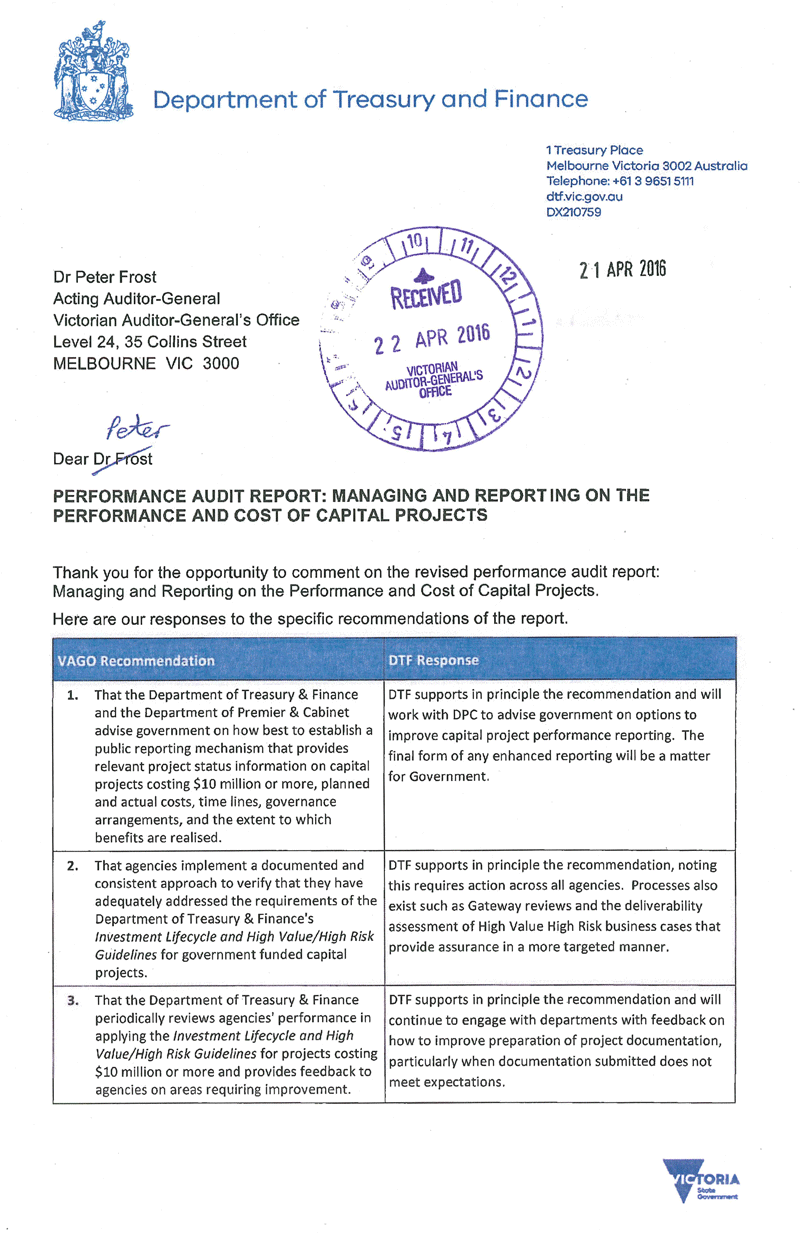
RESPONSE provided by the Secretary, Department of Treasury & Finance – continued
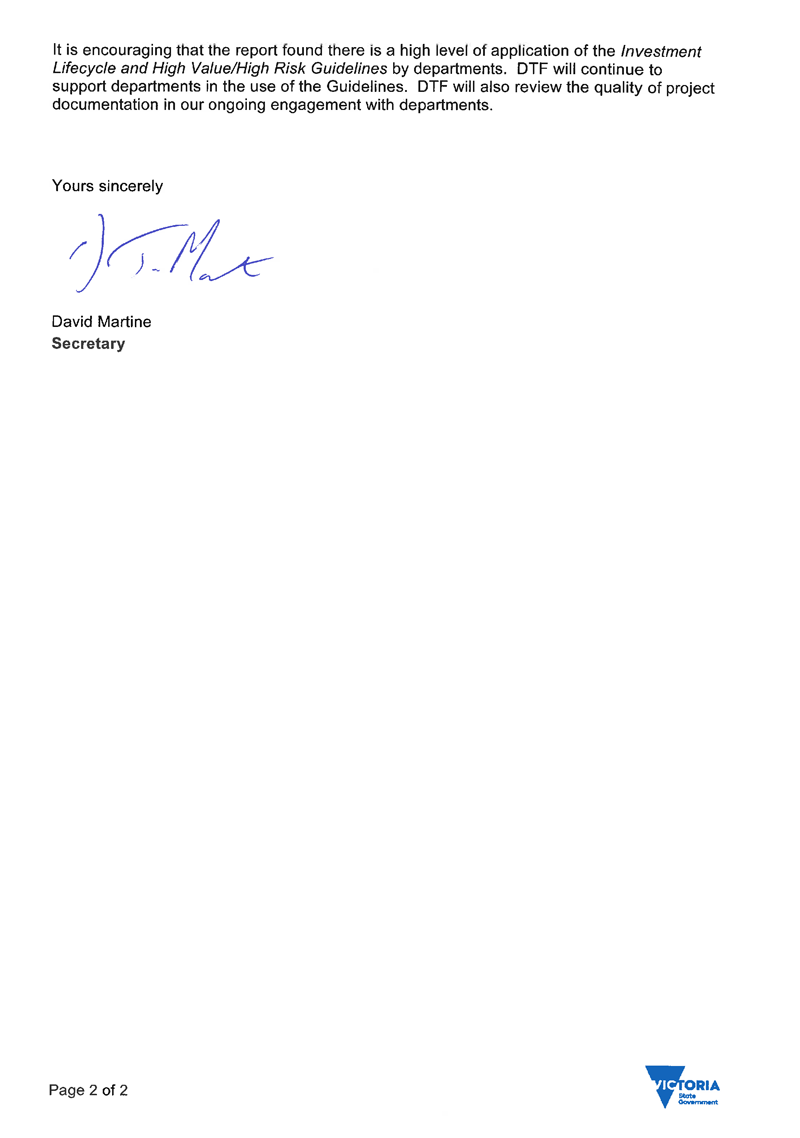
RESPONSE provided by the Secretary, Department of Premier & Cabinet
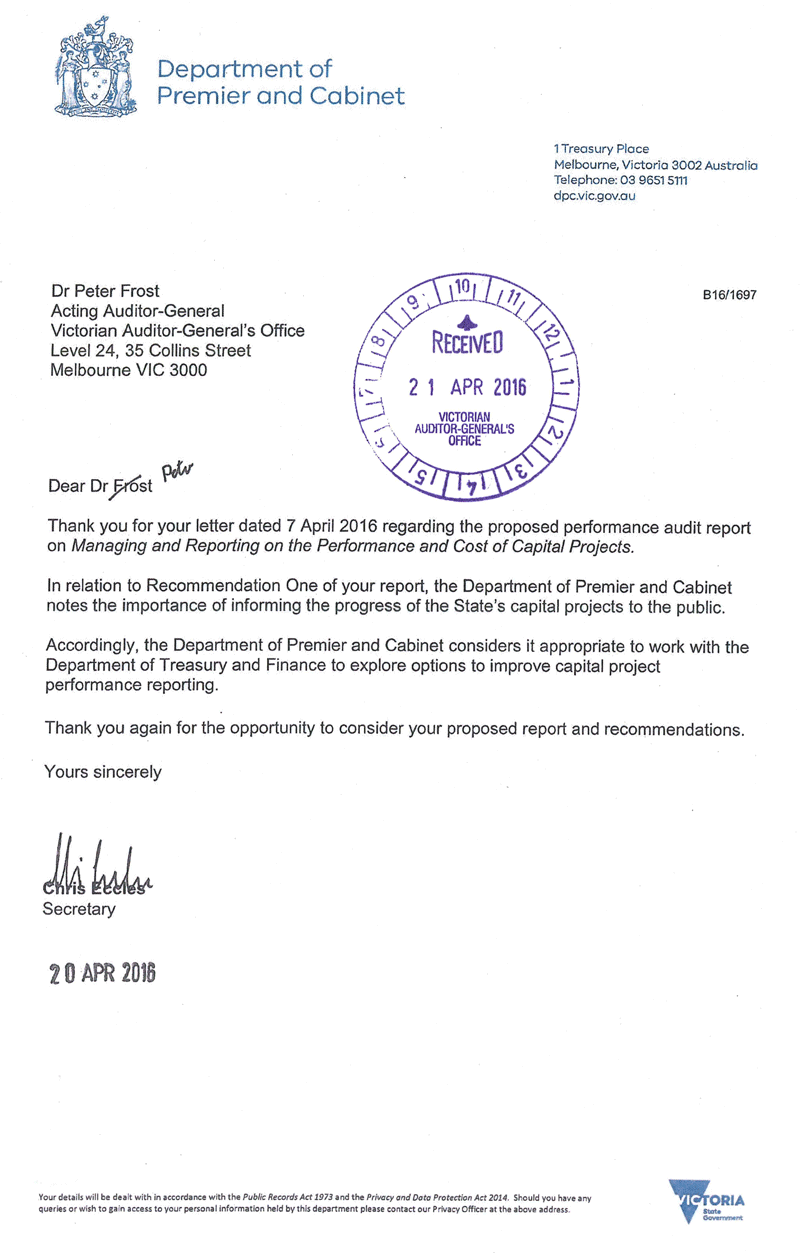
RESPONSE provided by the Secretary, Department of Environment, Land, Water & Planning
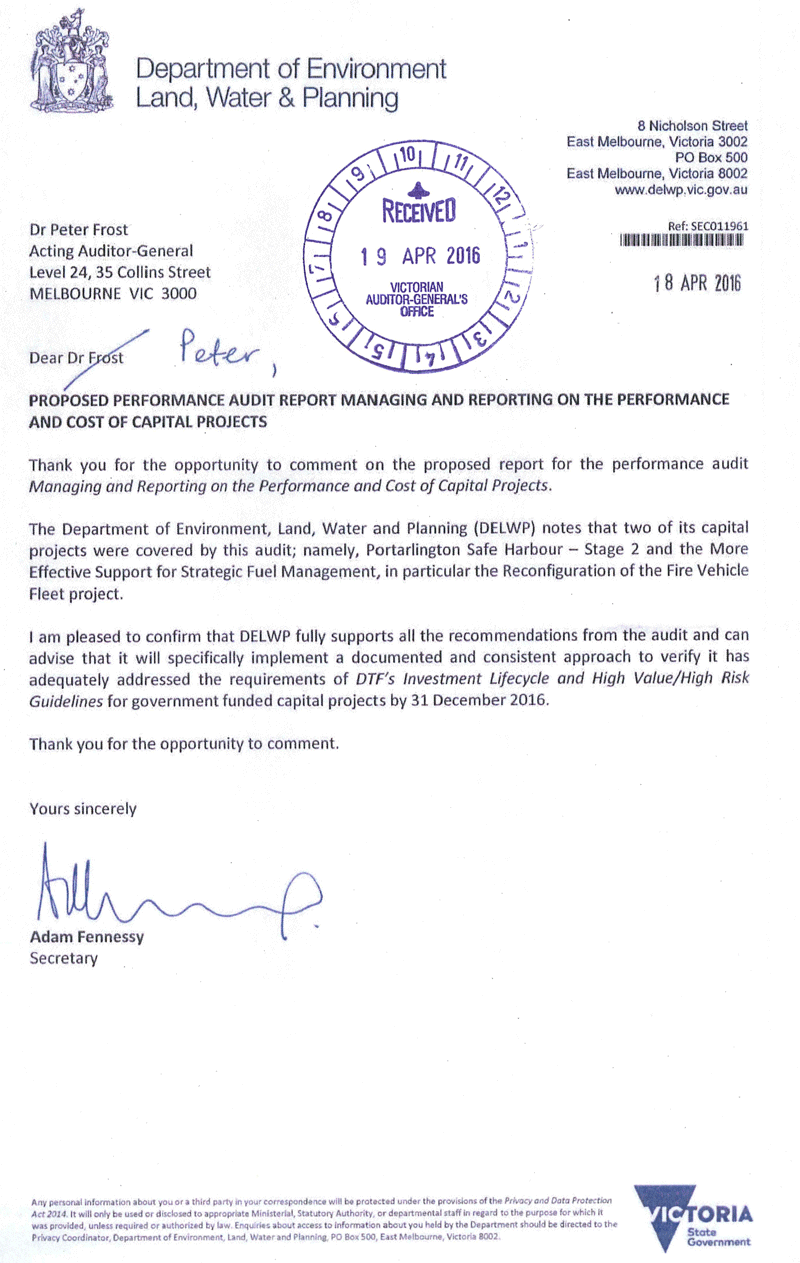
RESPONSE provided by the Secretary, Department of Education & Training
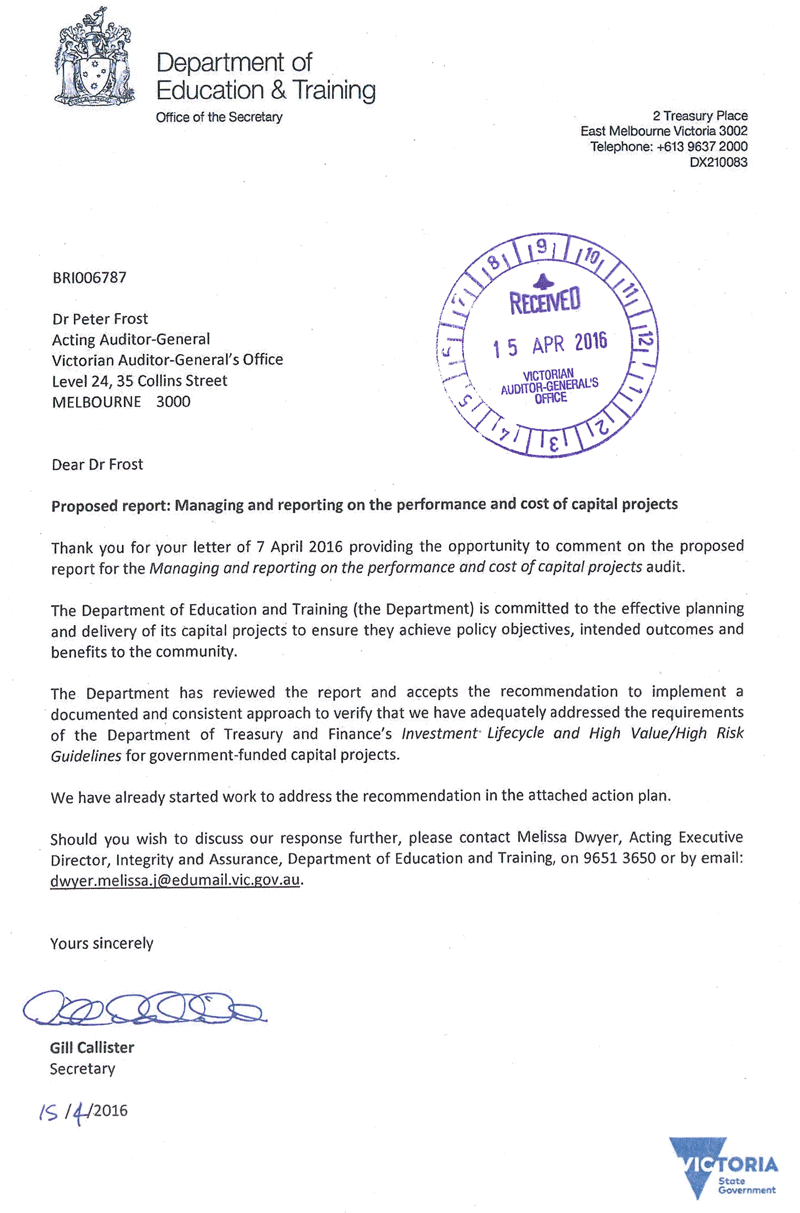
RESPONSE provided by the Secretary, Department of Education & Training – continued
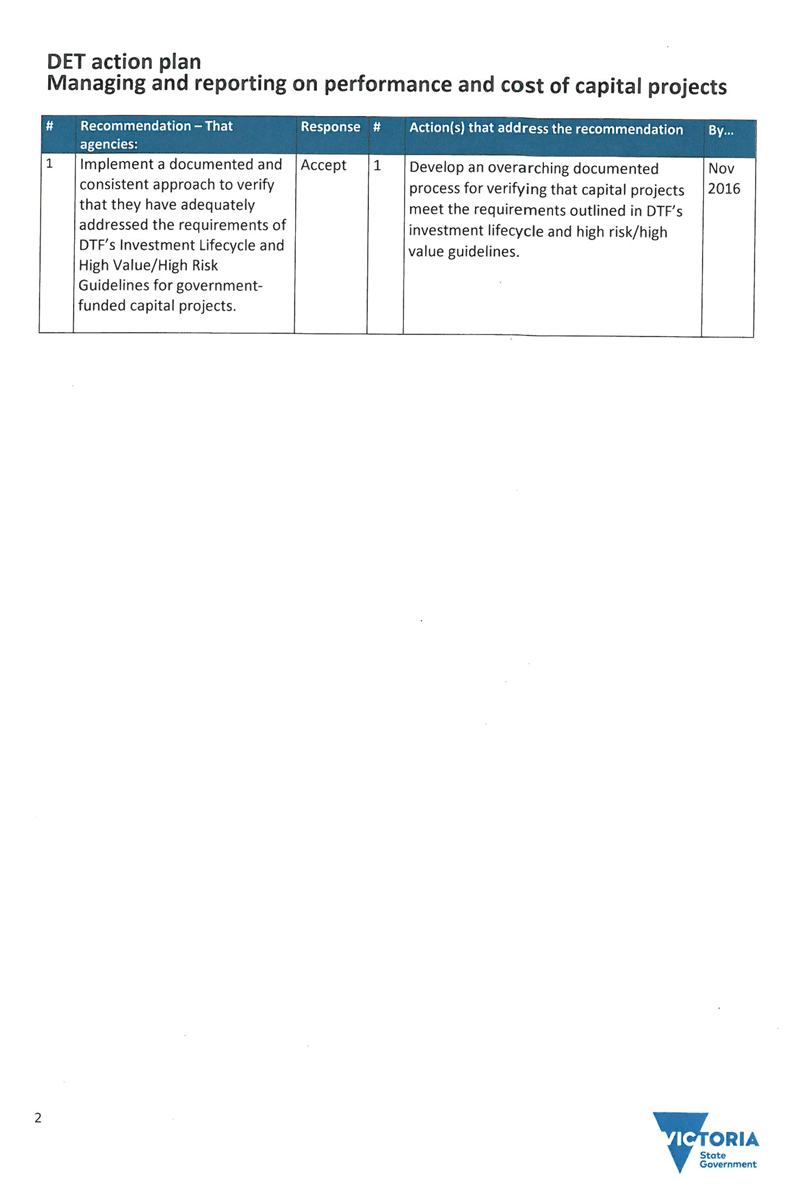
RESPONSE provided by the Secretary, Department of Justice & Regulation
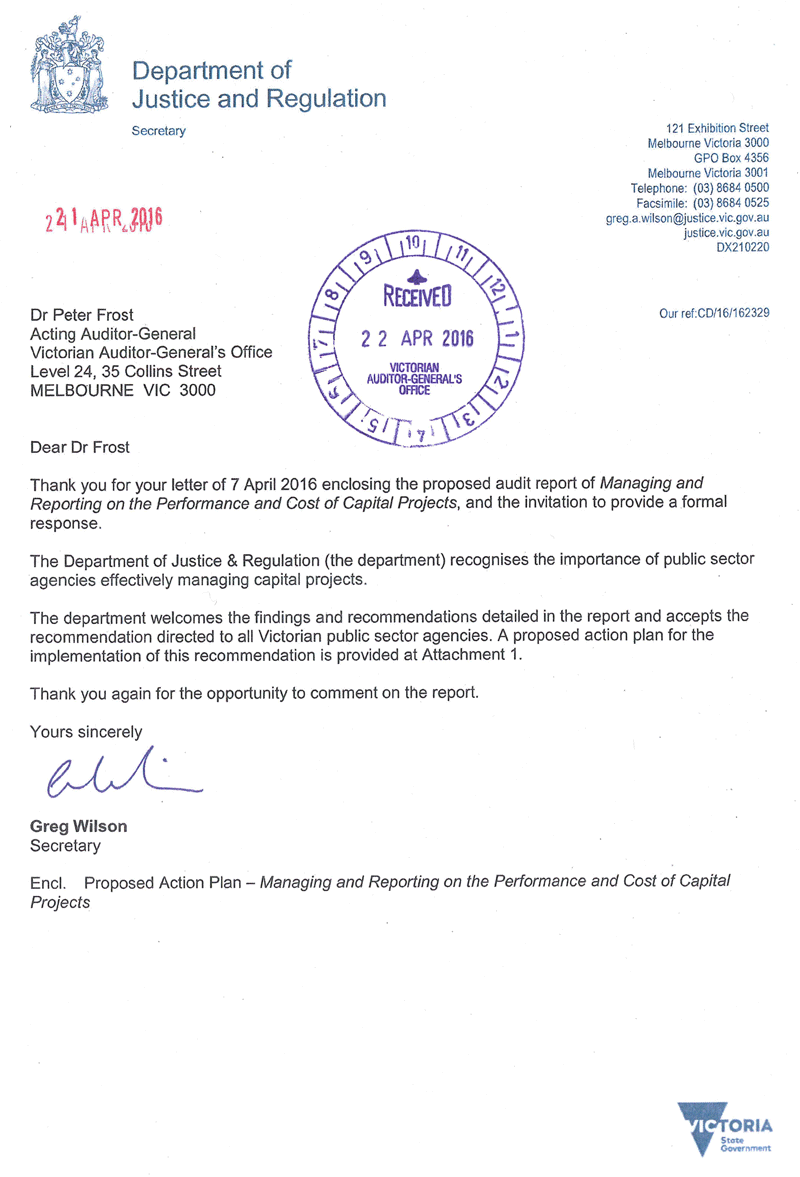
RESPONSE provided by the Secretary, Department of Justice & Regulation – continued
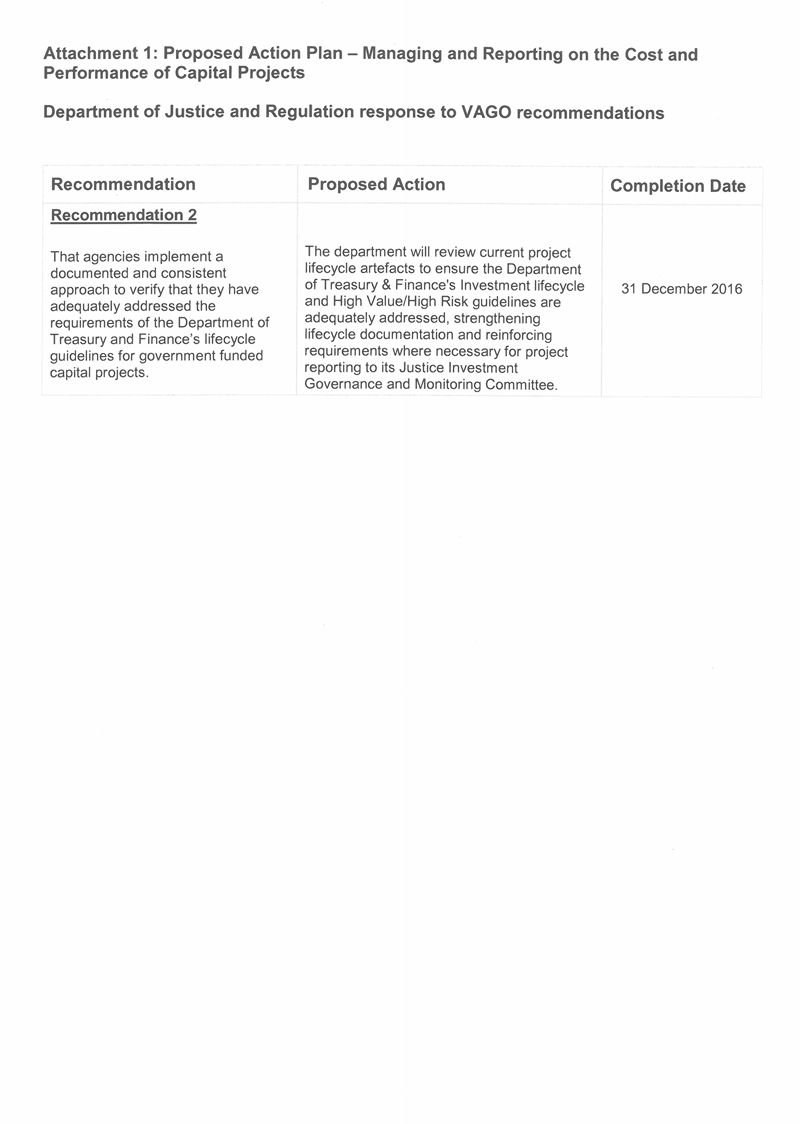
RESPONSE provided by the Secretary, Department of Health & Human Services
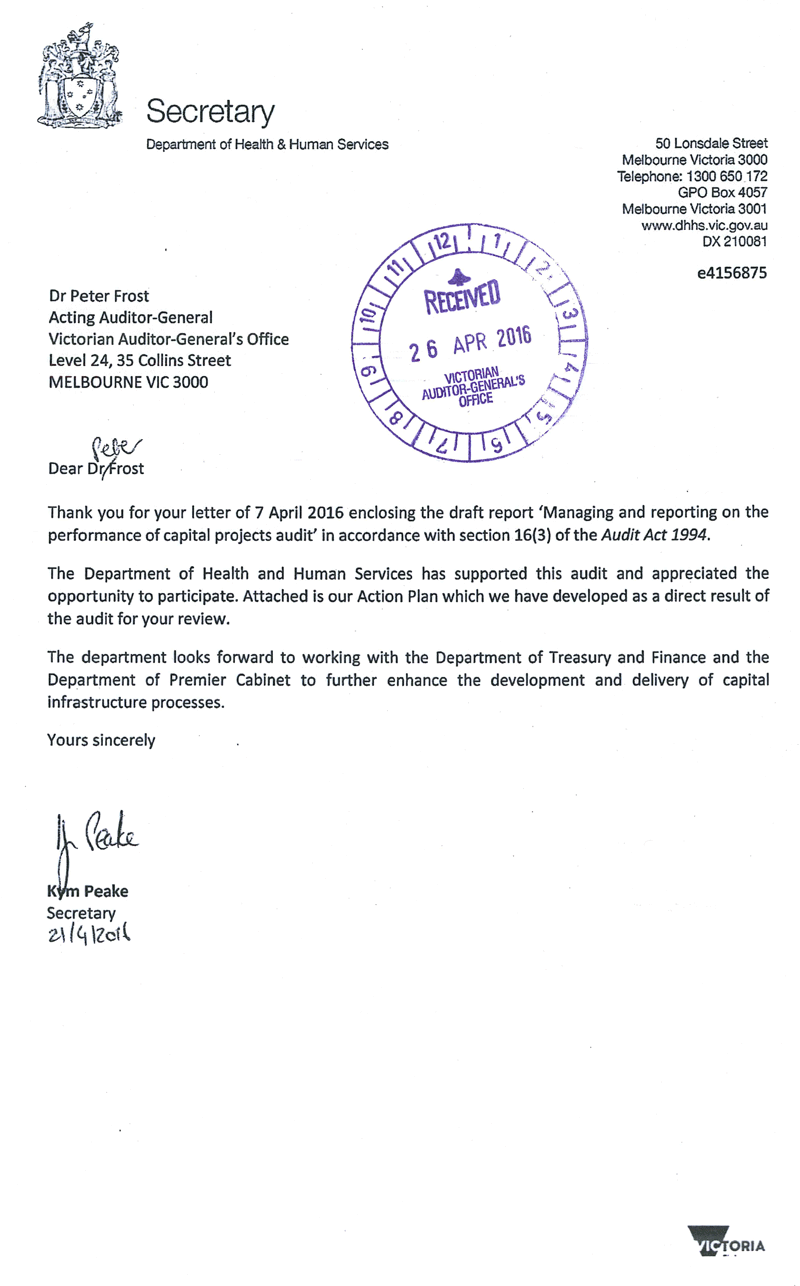
RESPONSE provided by the Secretary, Department of Health & Human Services – continued

RESPONSE provided by the Chief Commissioner, Victoria Police

RESPONSE provided by the Chief Commissioner, Victoria Police–continued
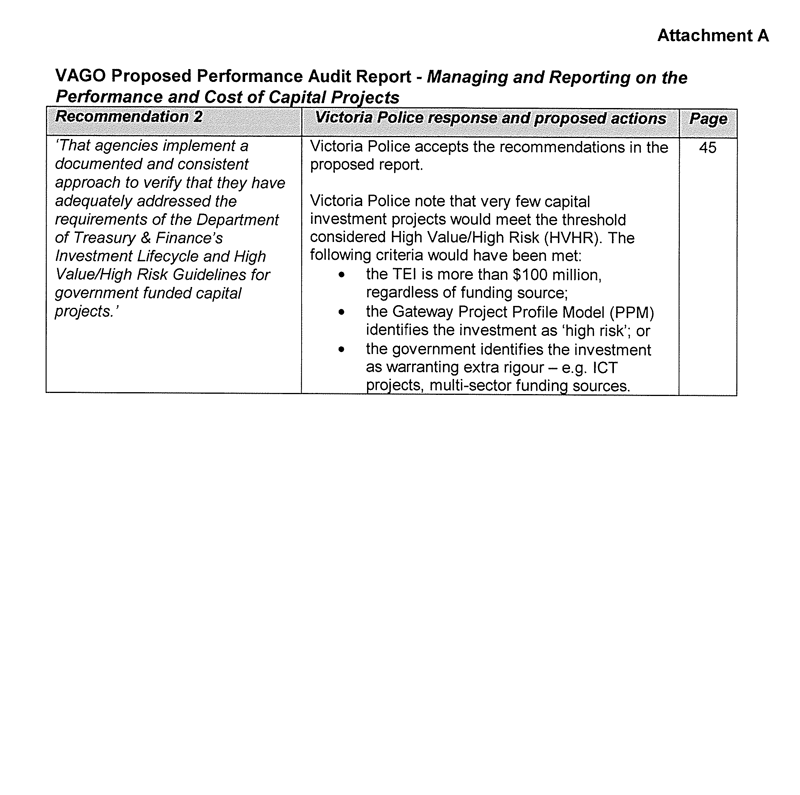
RESPONSE provided by the Chief Executive Officer, Public Transport Victoria

RESPONSE provided by the Chief Executive Officer, Public Transport Victoria – continued

RESPONSE provided by the Chief Executive Officer, Port of Melbourne Corporation
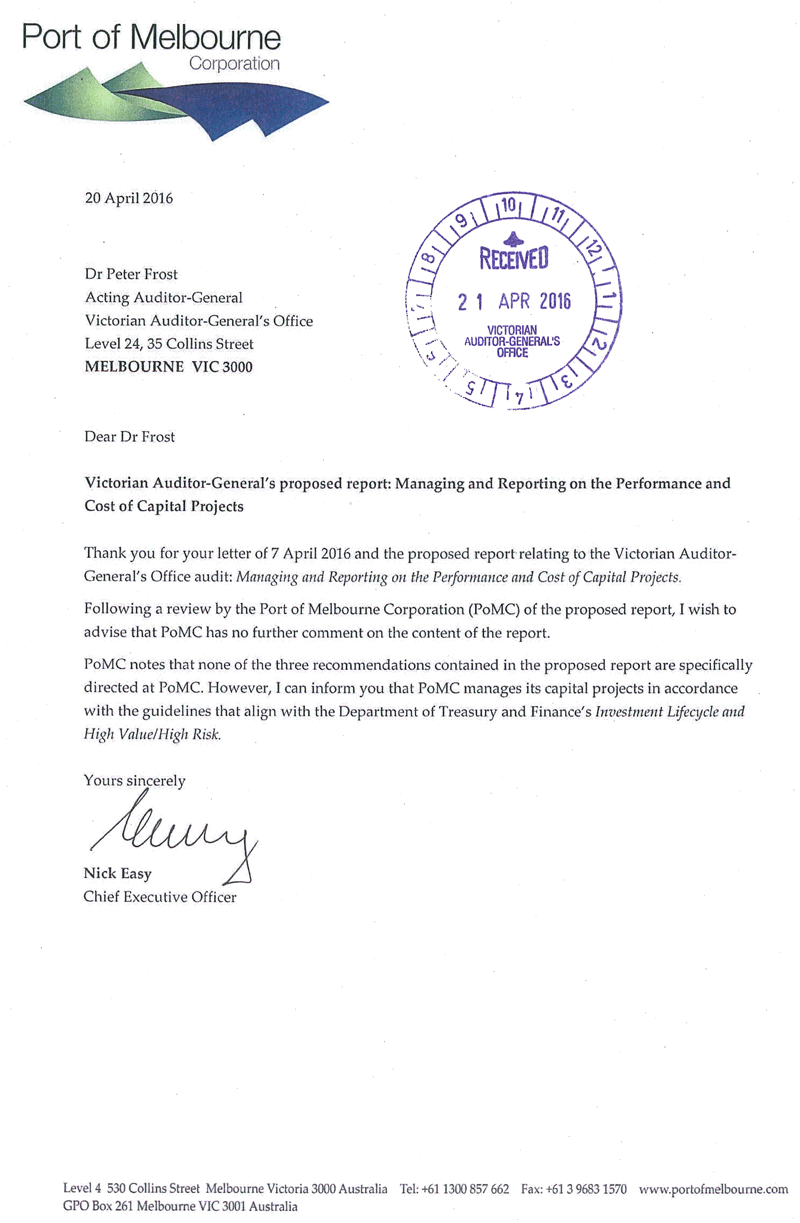
RESPONSE provided by the Managing Director, Barwon Water
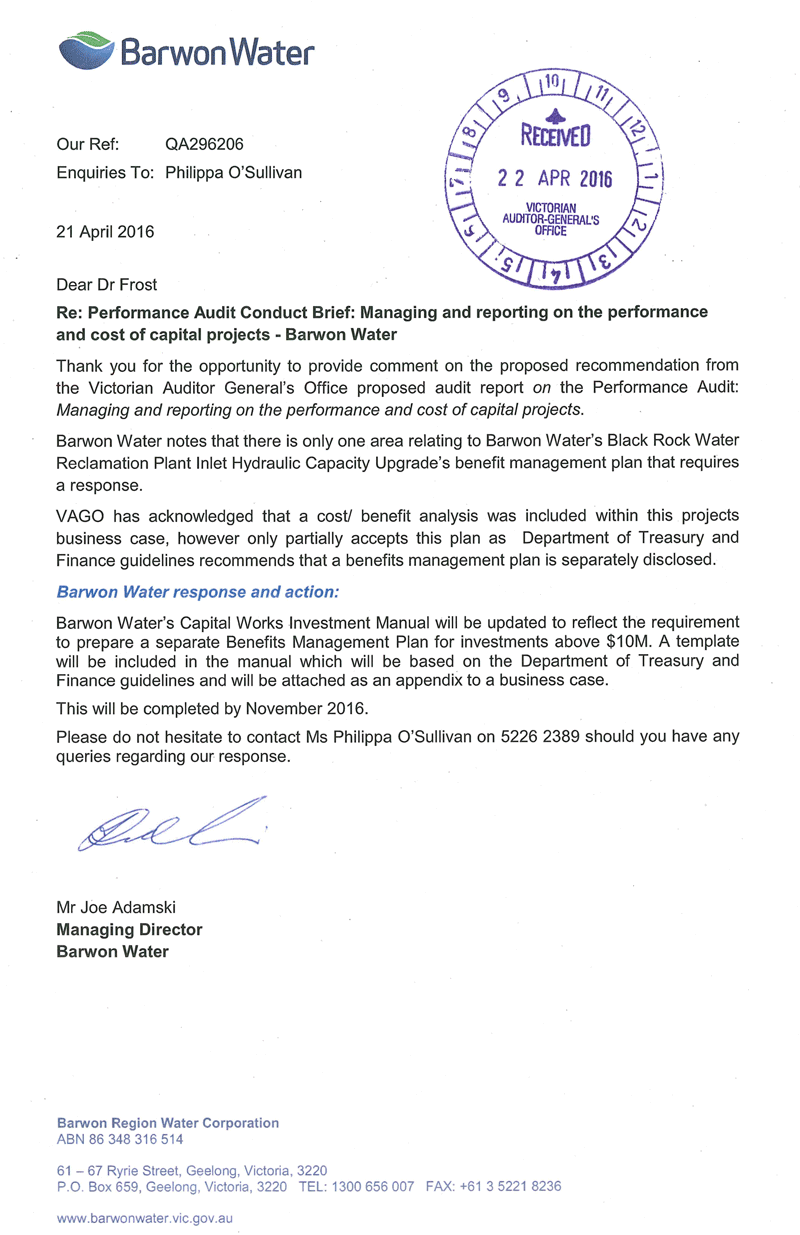
RESPONSE provided by the Managing Director, Gippsland Water
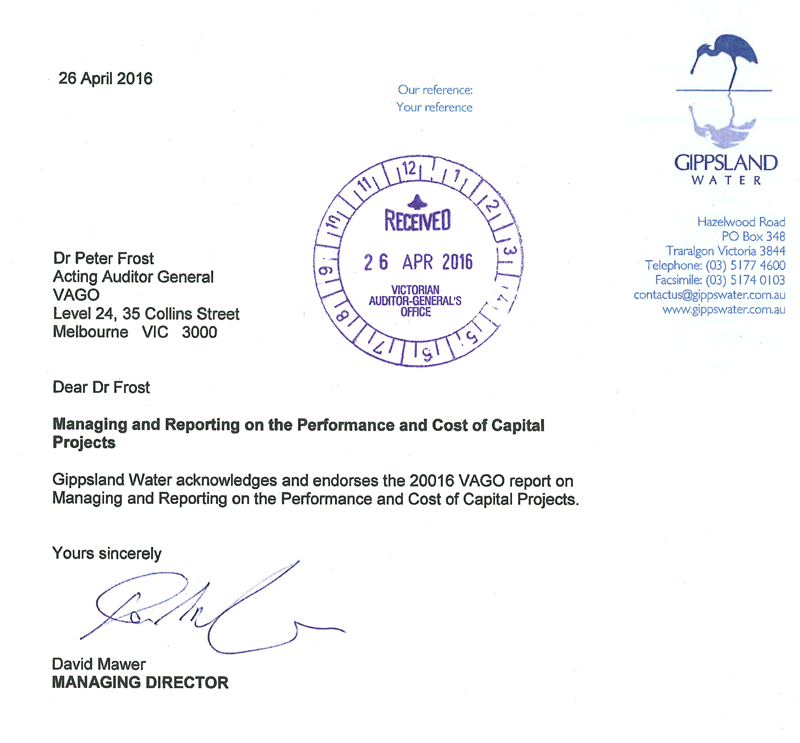
RESPONSE provided by the Chief Executive Officer, V/Line

RESPONSE provided by the Chief Executive Officer, V/Line – continued
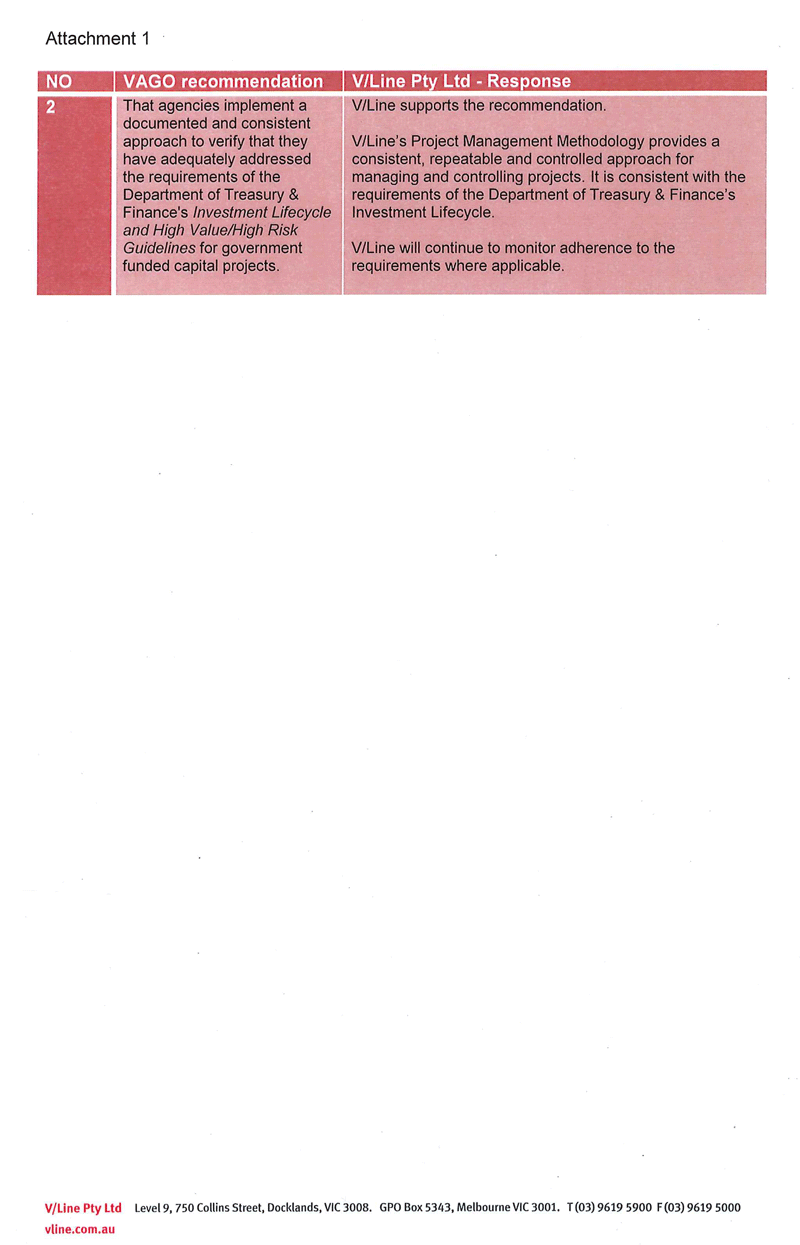
RESPONSE provided by the CFO and GM, Corporate Services, Places Victoria
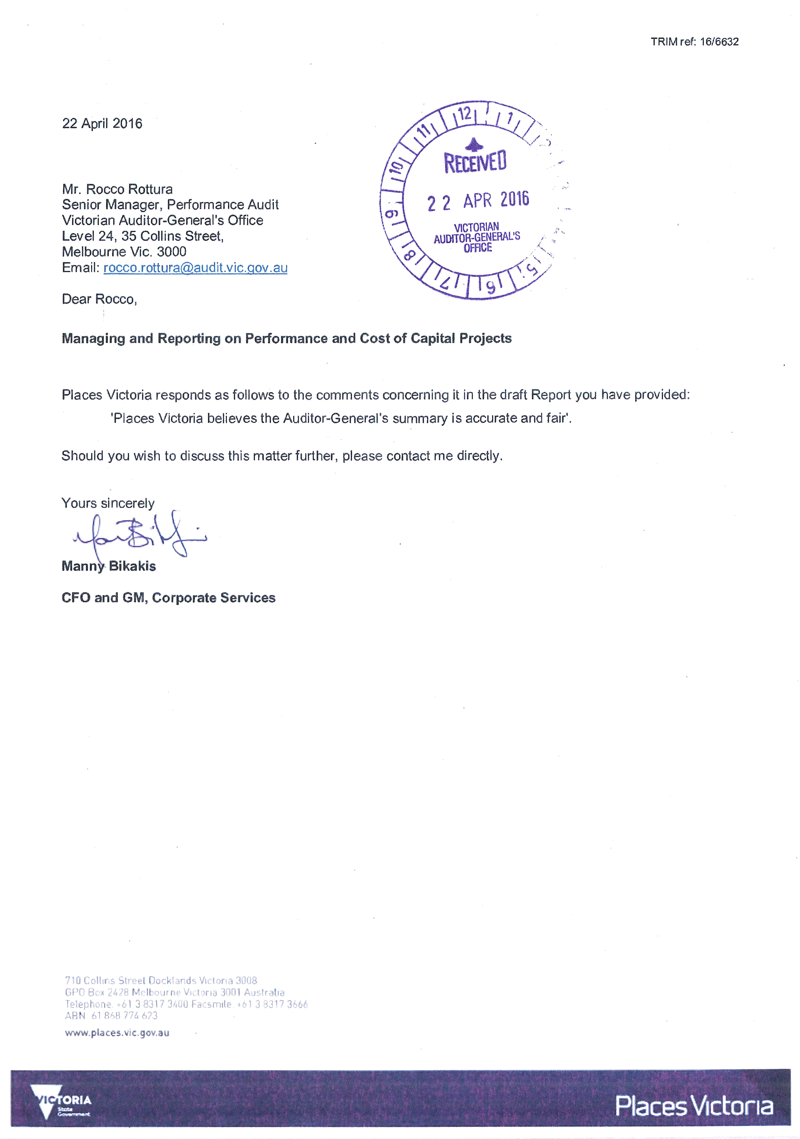
RESPONSE provided by the Chief Executive, VicRoads

RESPONSE provided by the Chief Executive, VicRoads – continued
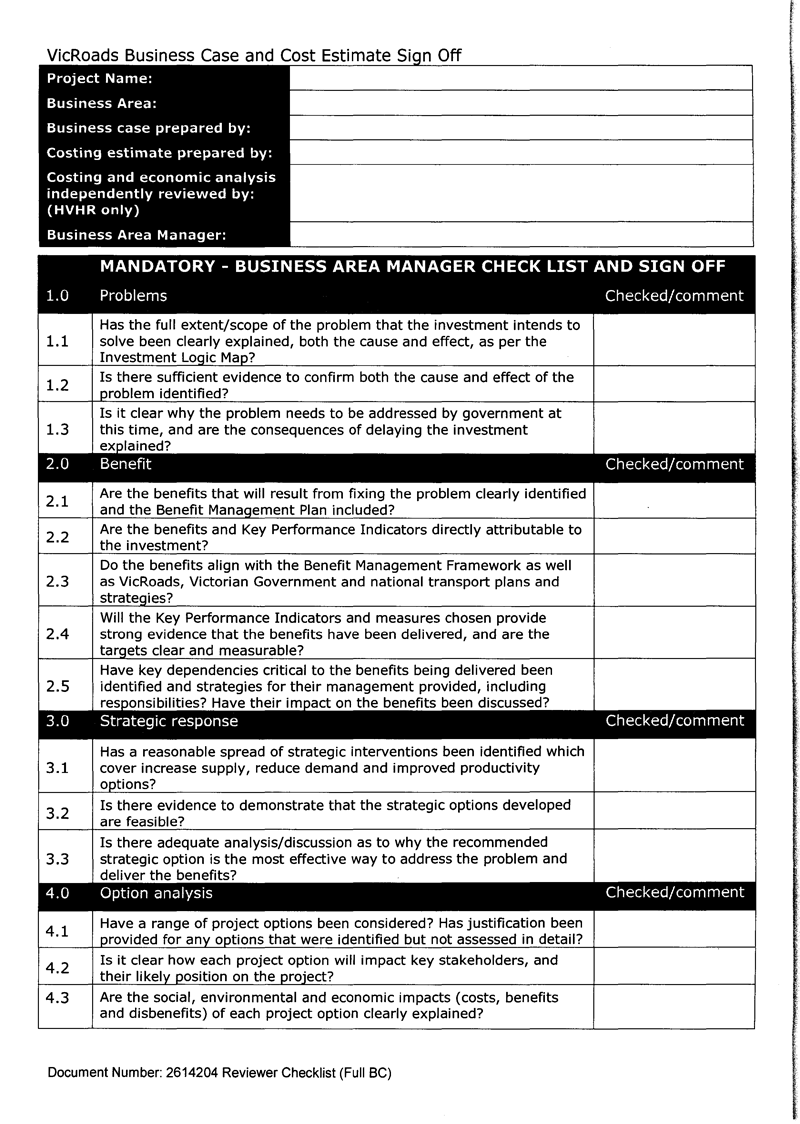
RESPONSE provided by the Chief Executive, VicRoads – continued
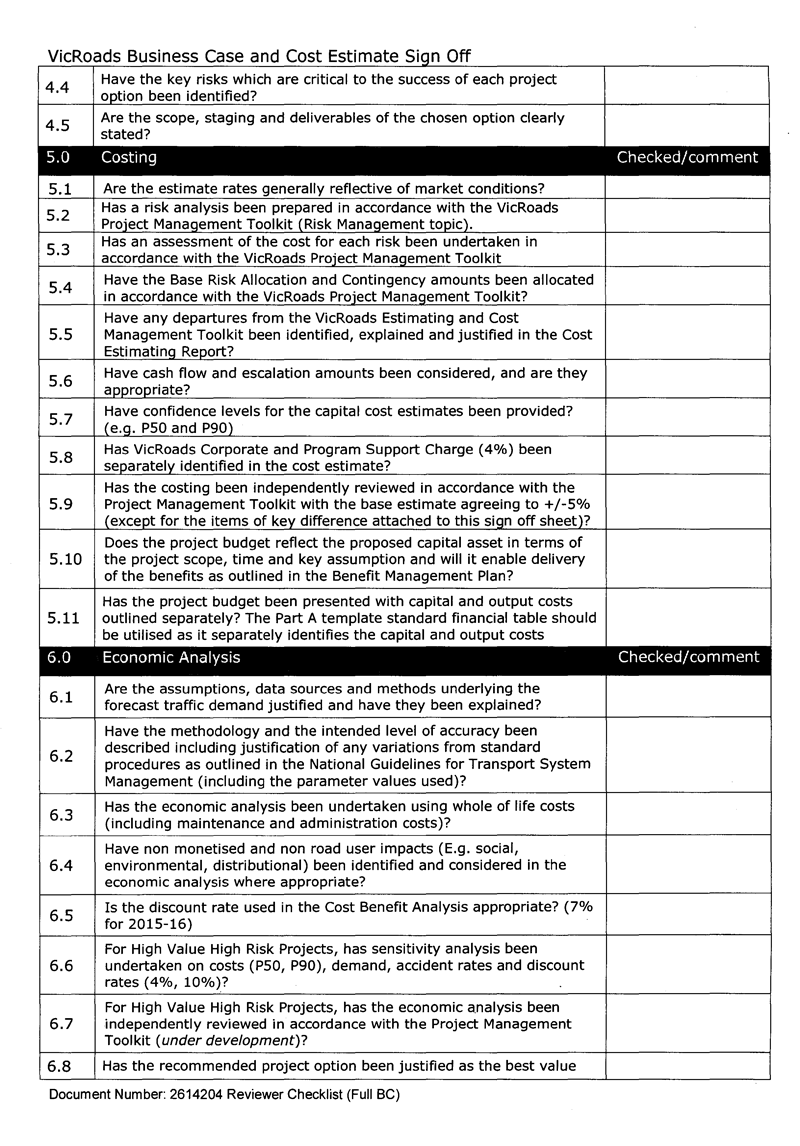
RESPONSE provided by the Chief Executive, VicRoads – continued

RESPONSE provided by the Chief Executive, VicRoads – continued
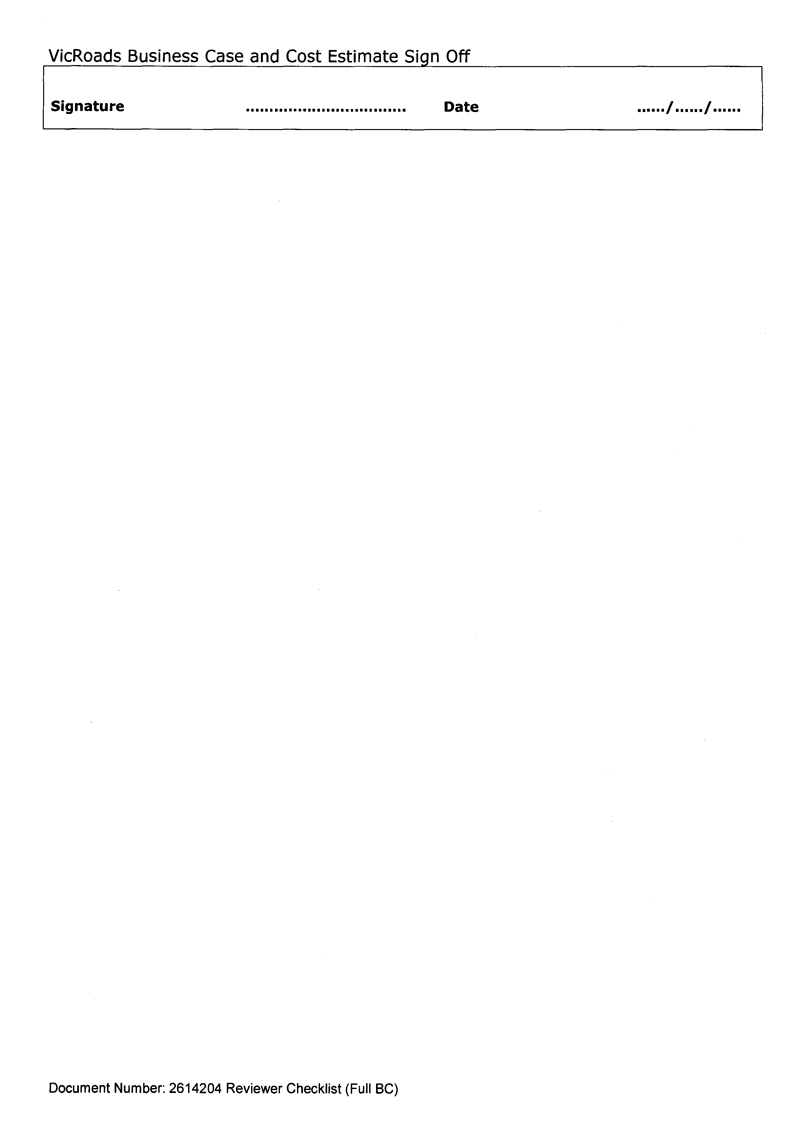
RESPONSE provided by the Chief Executive, VicRoads – continued

RESPONSE provided by the Chief Executive, VicRoads – continued

